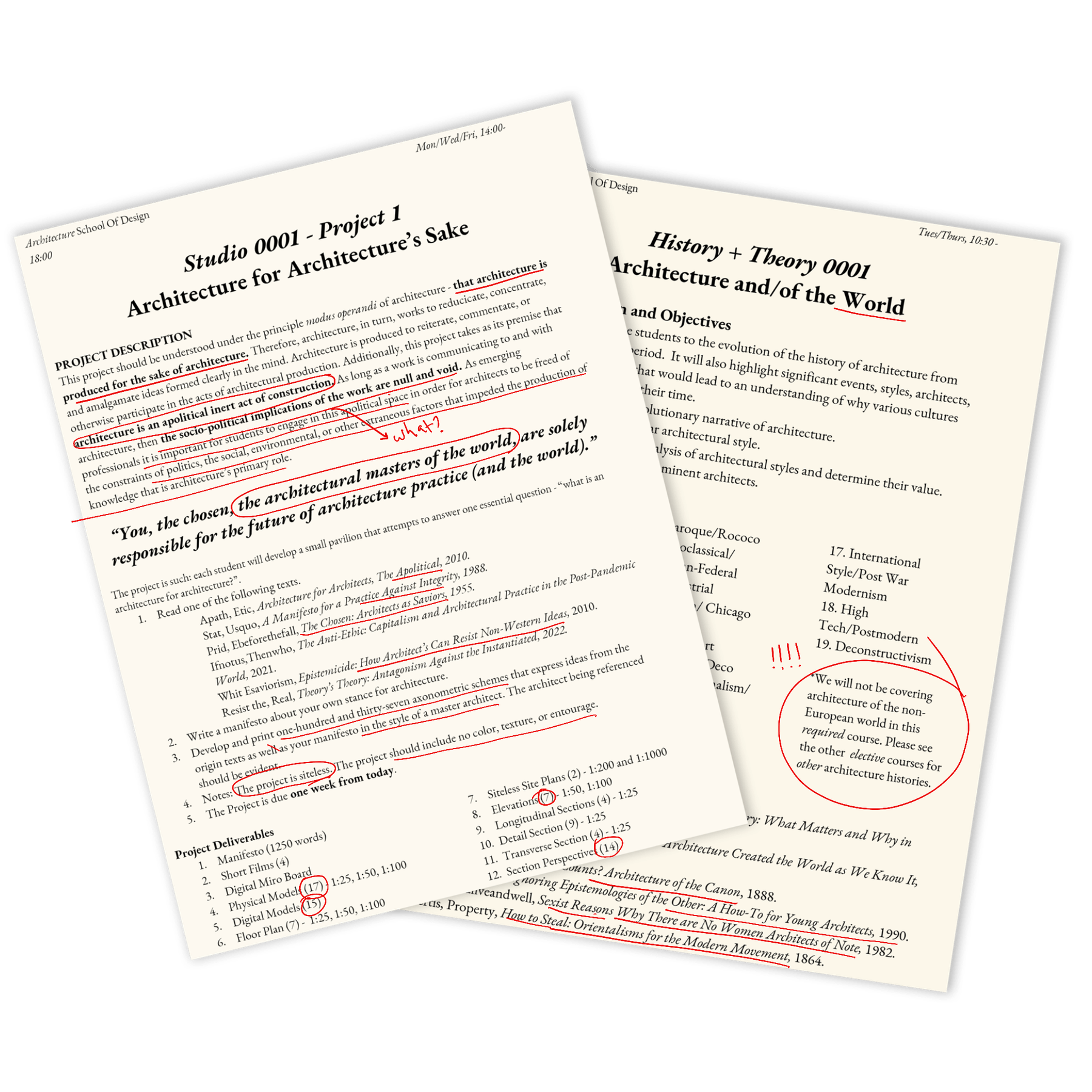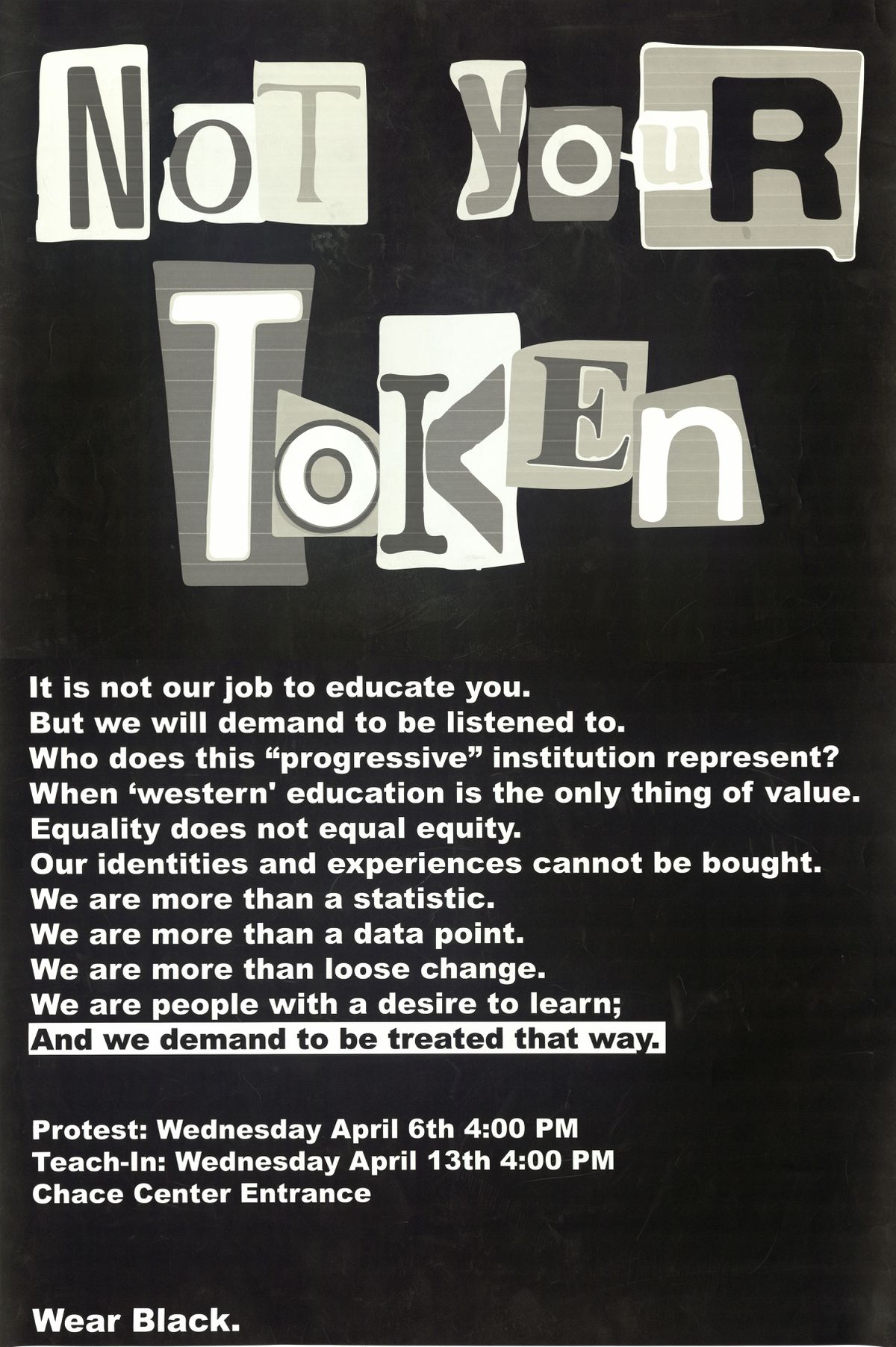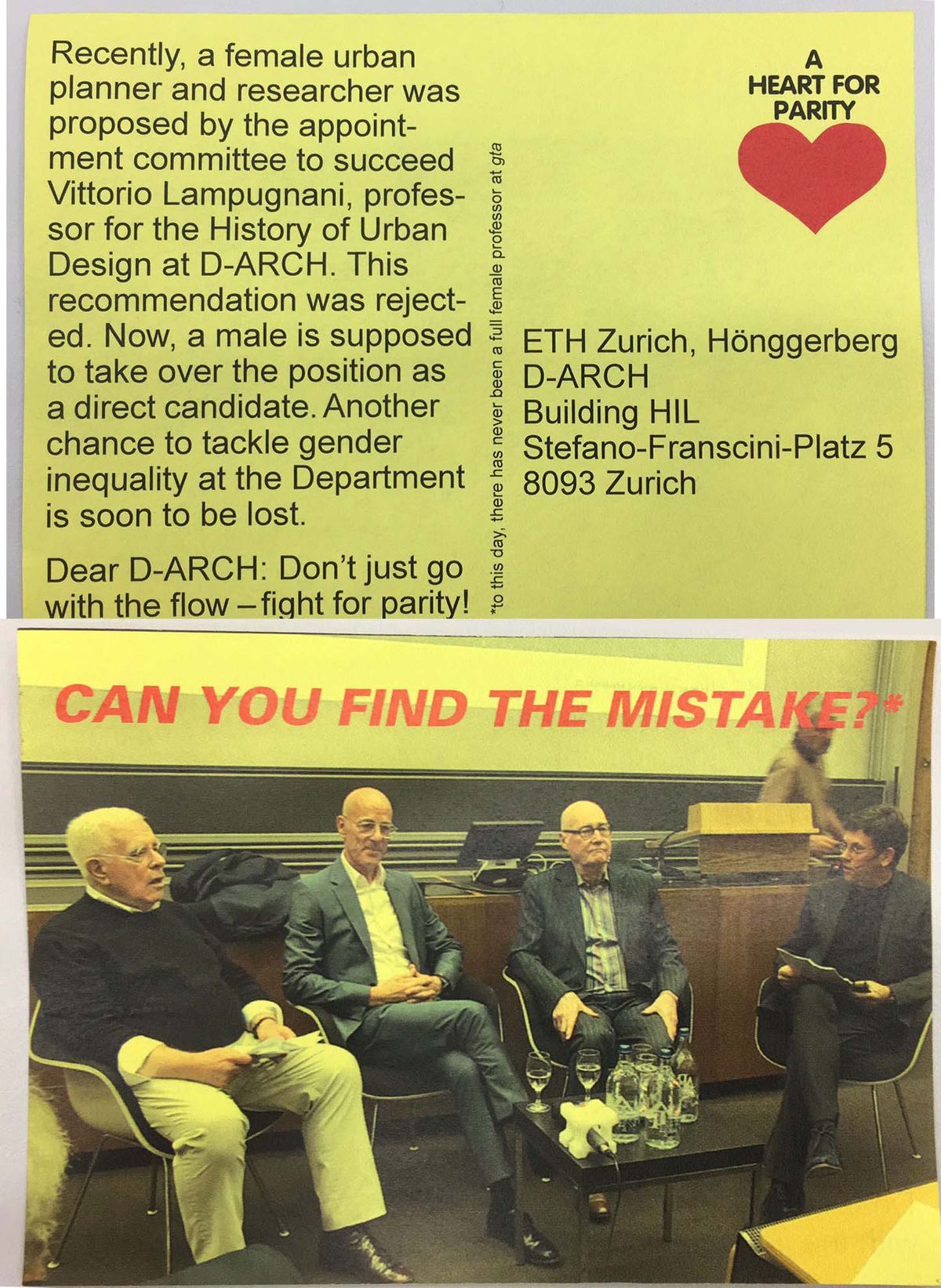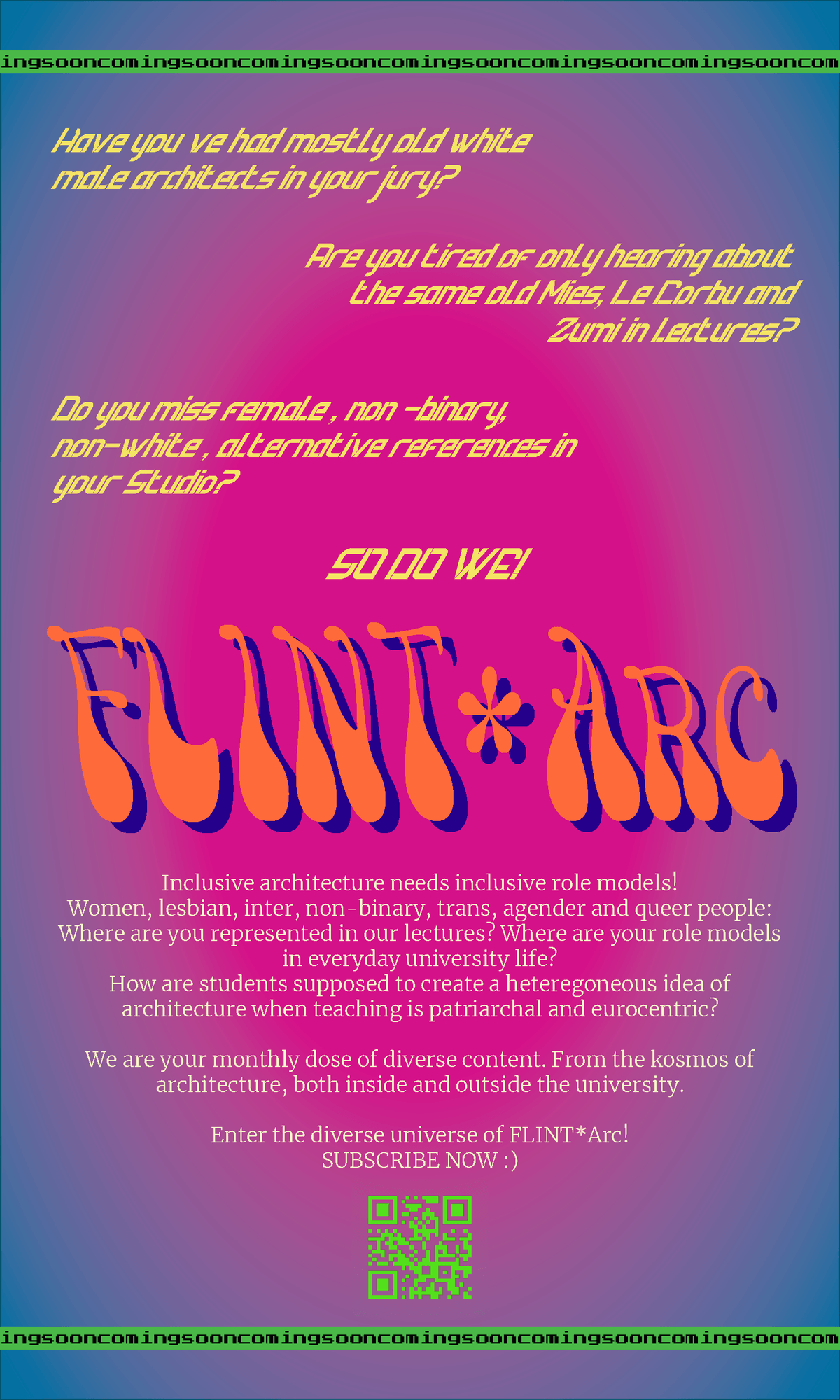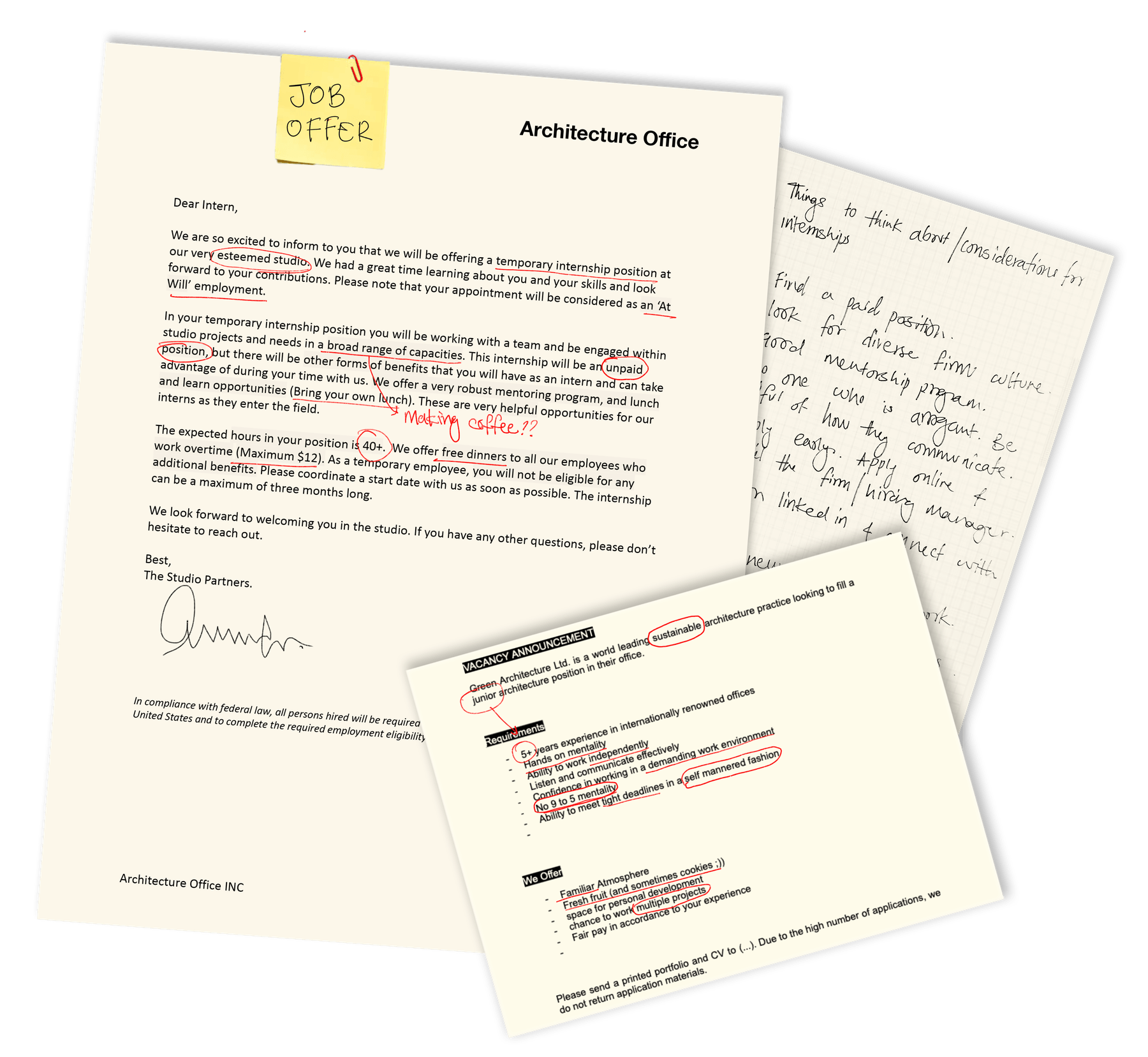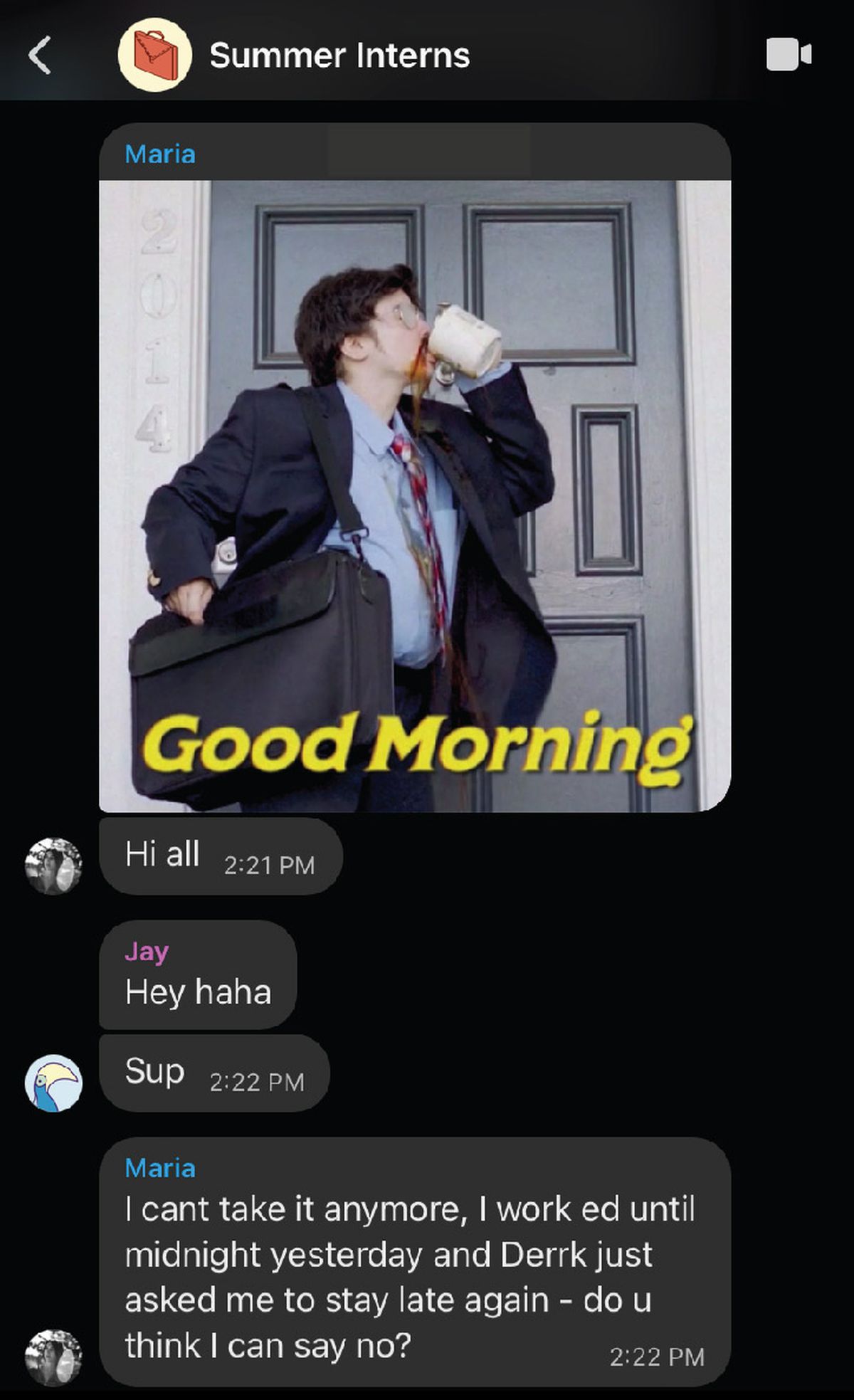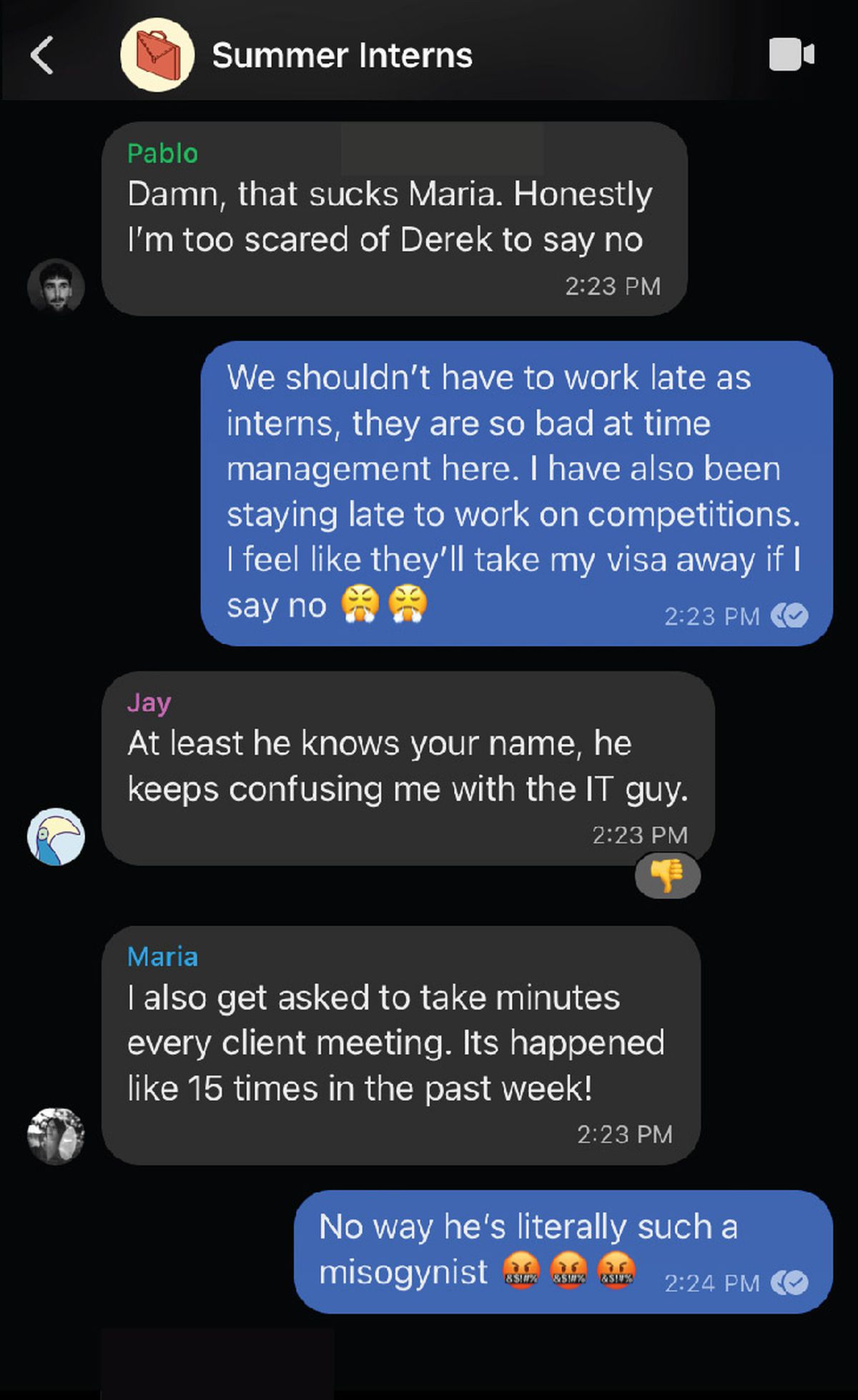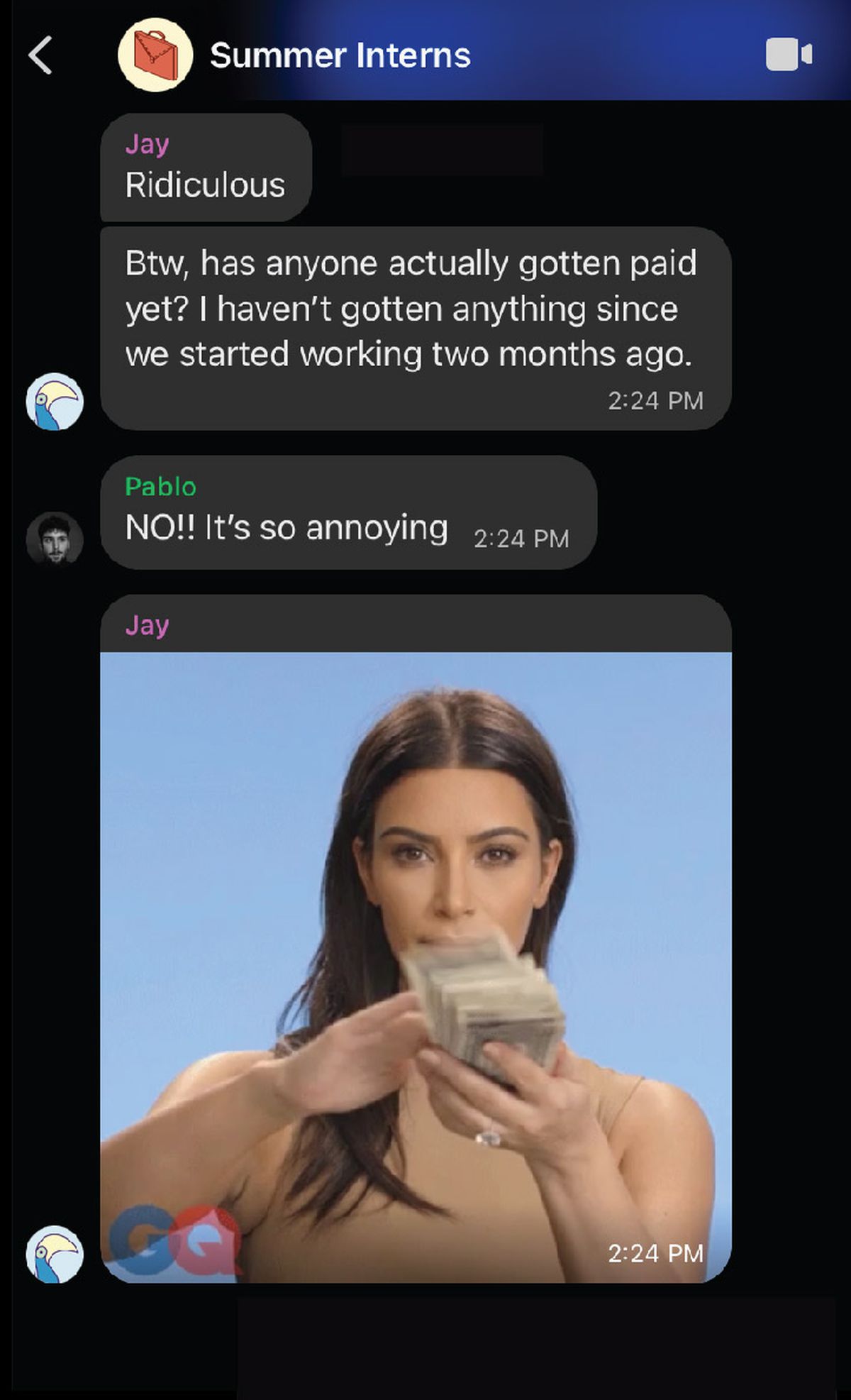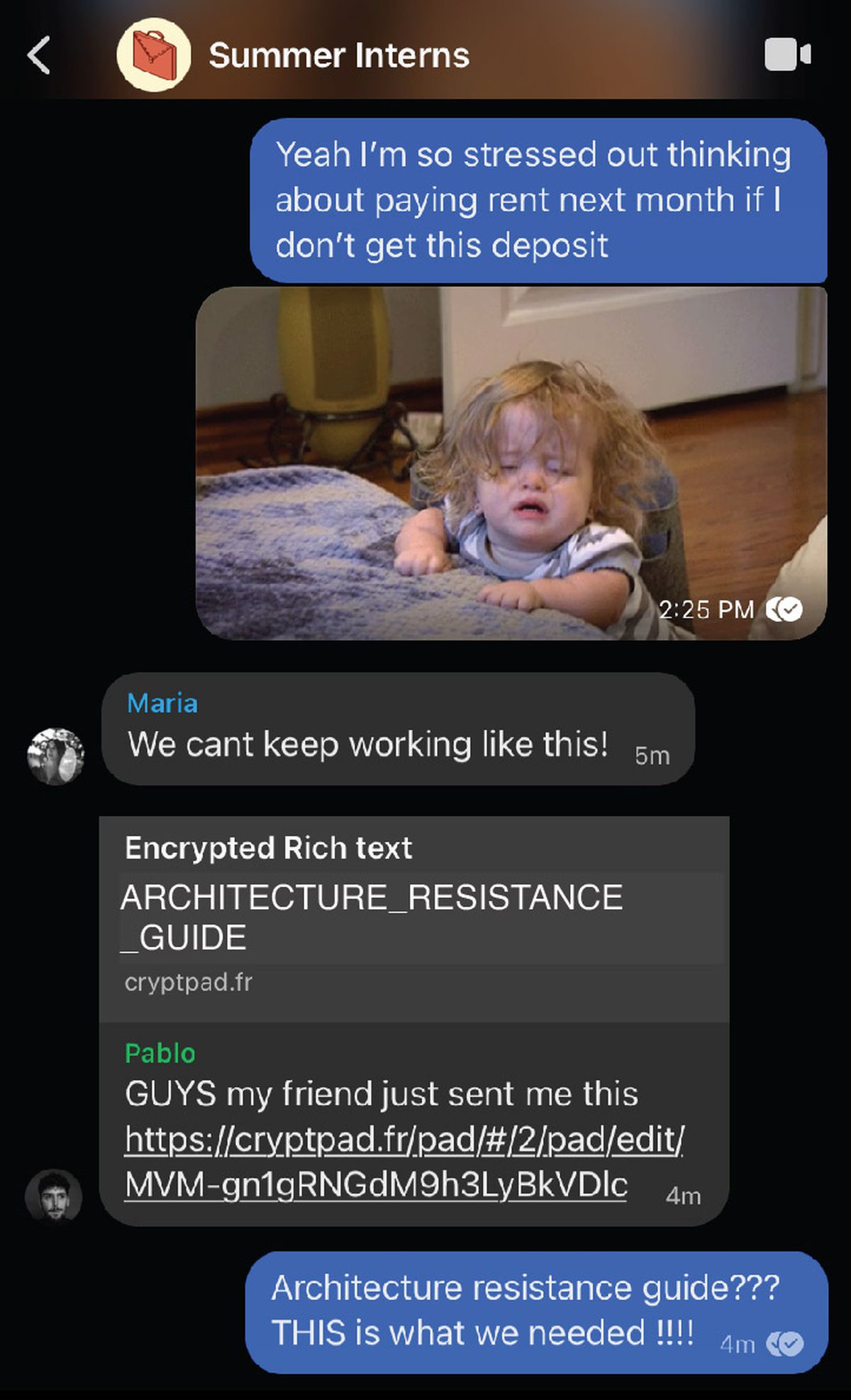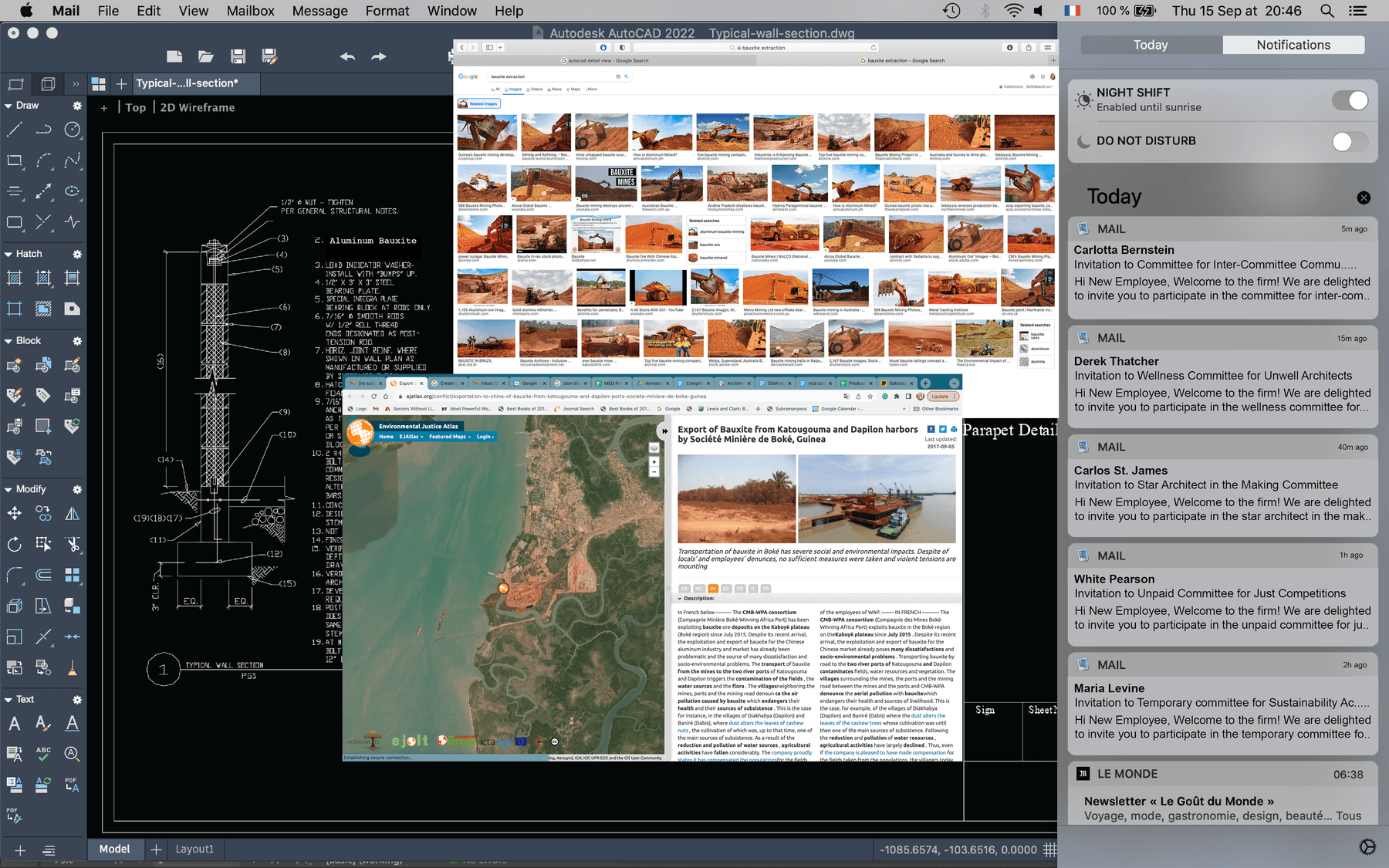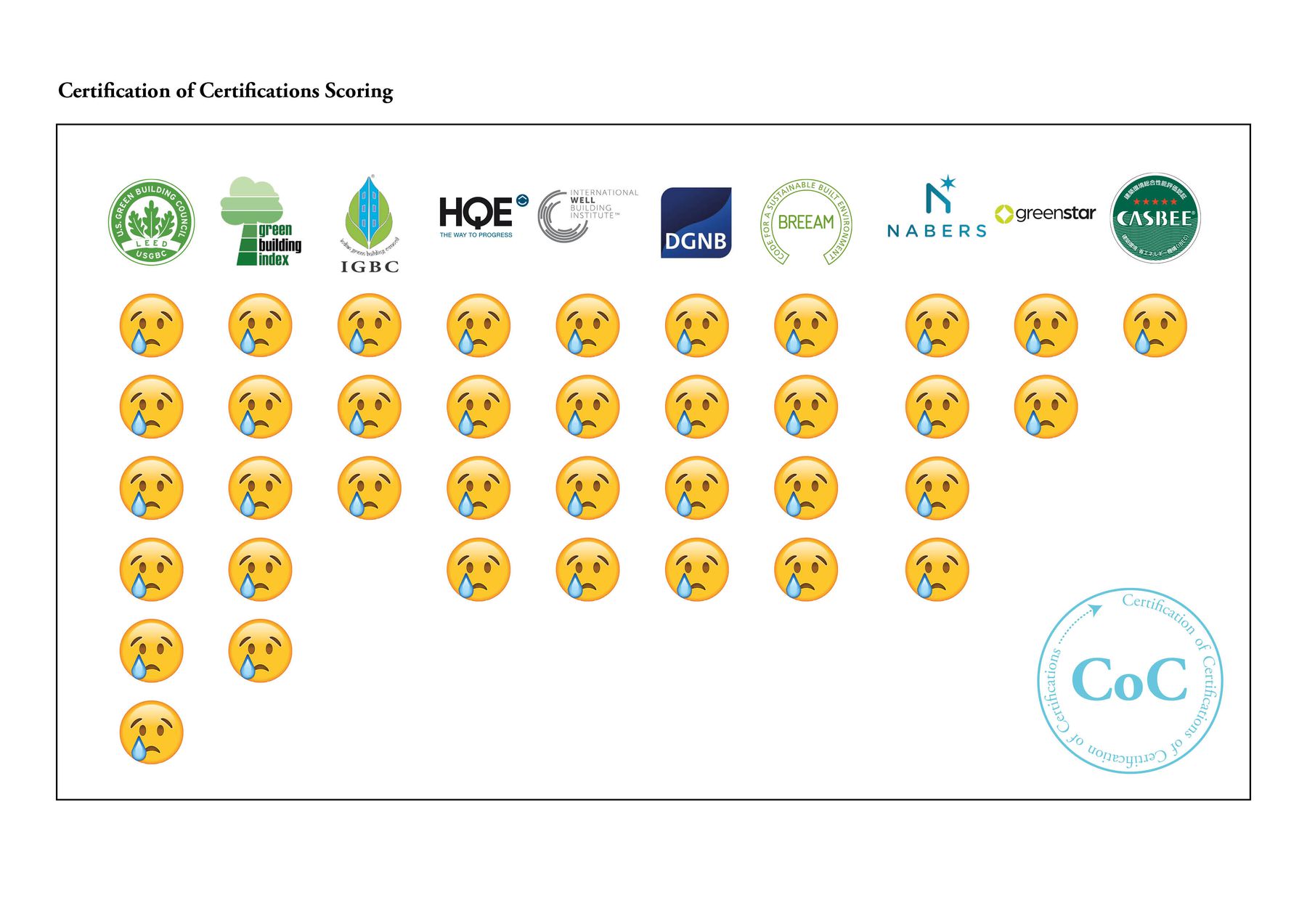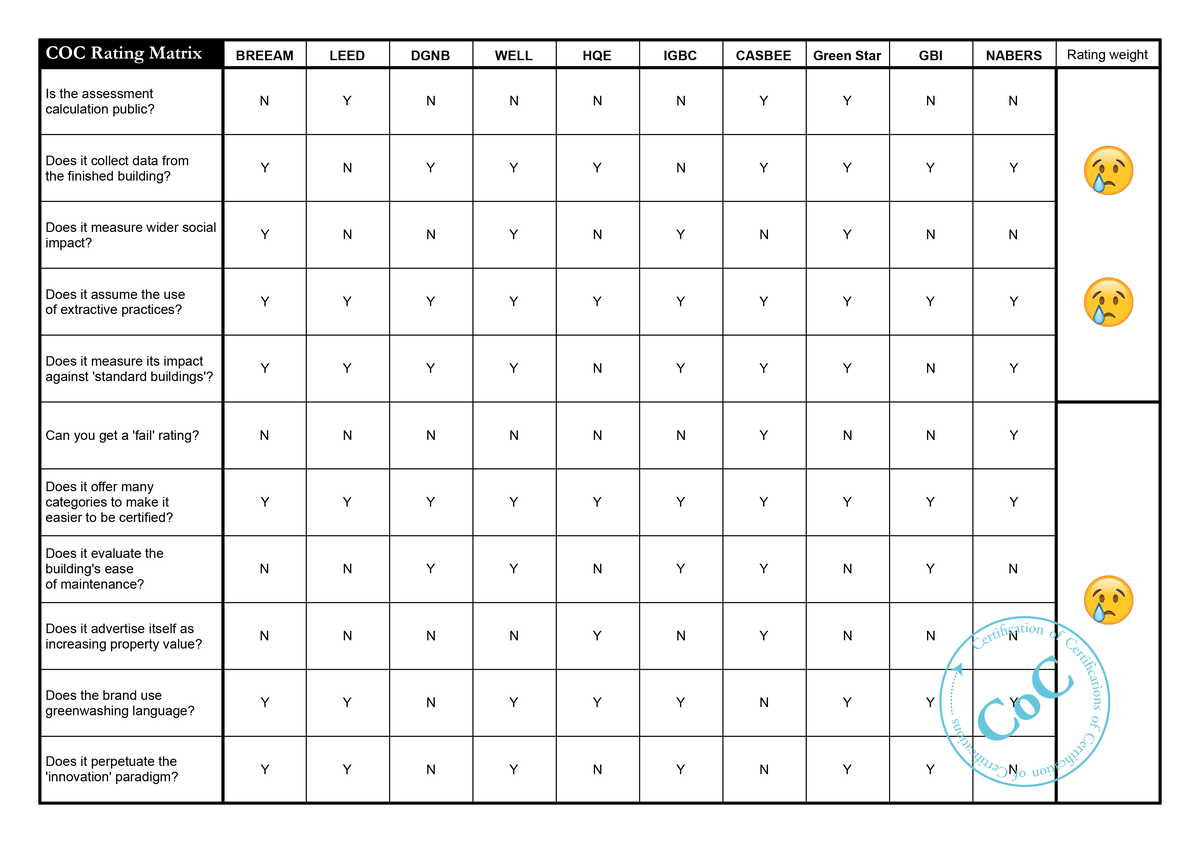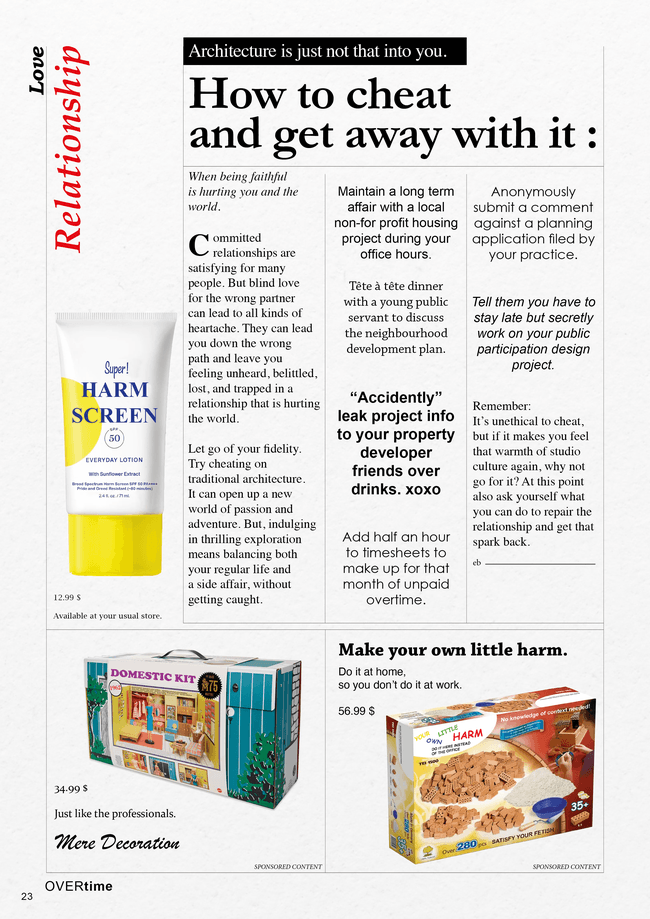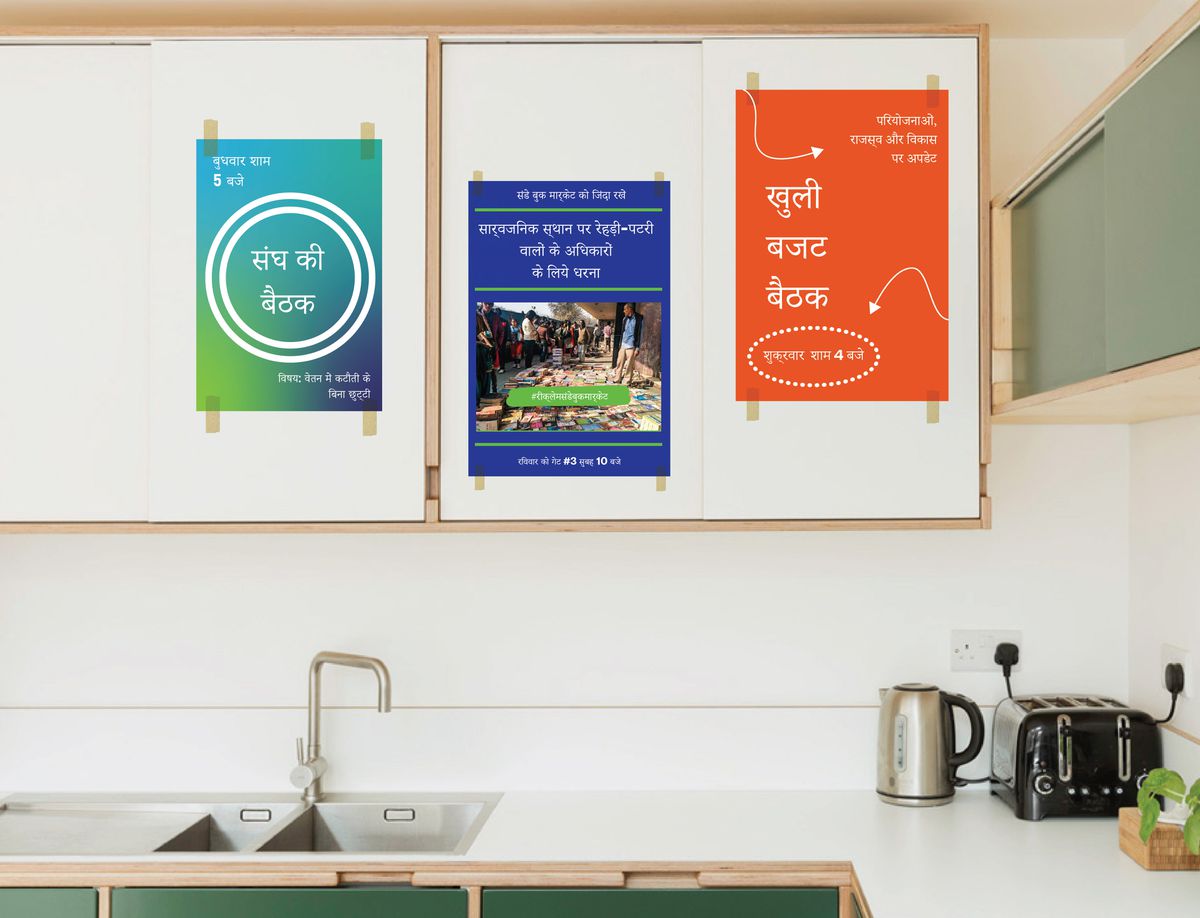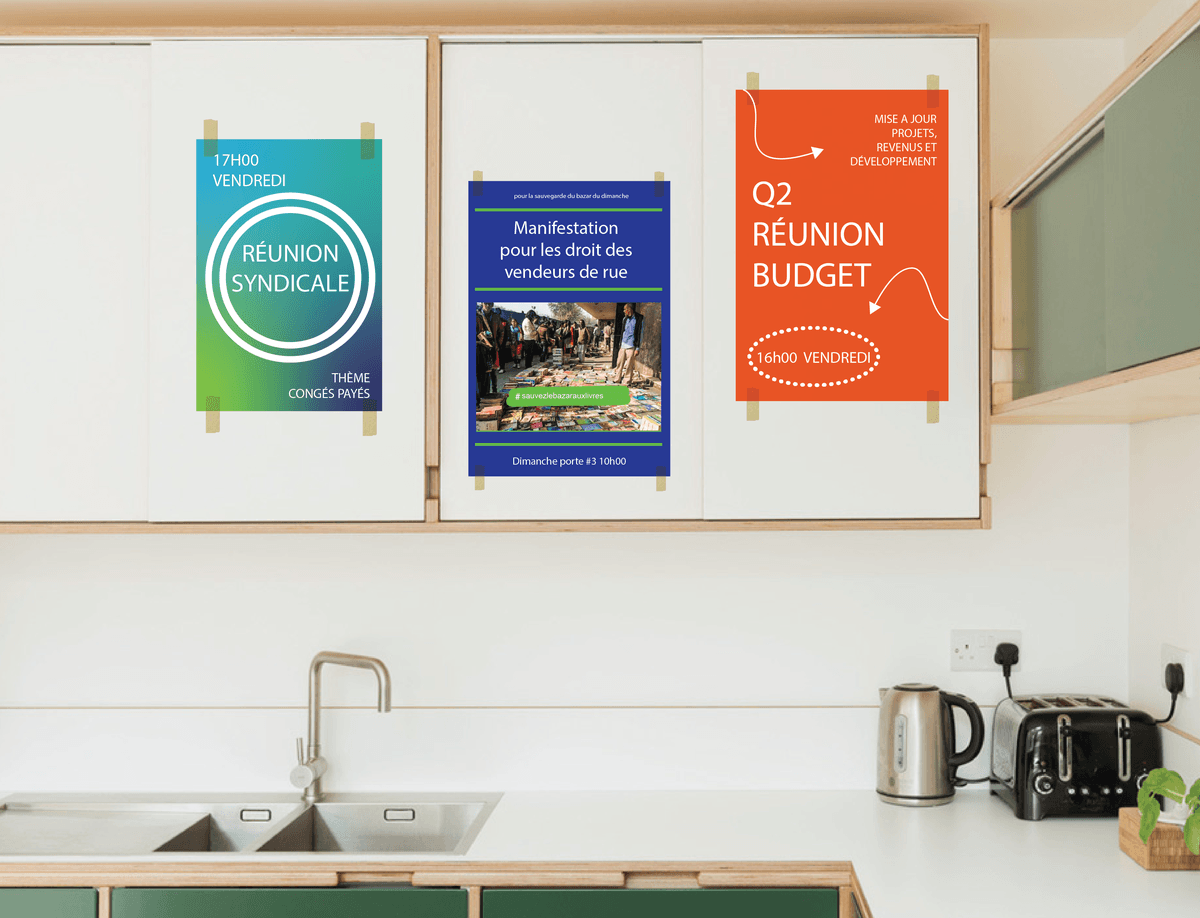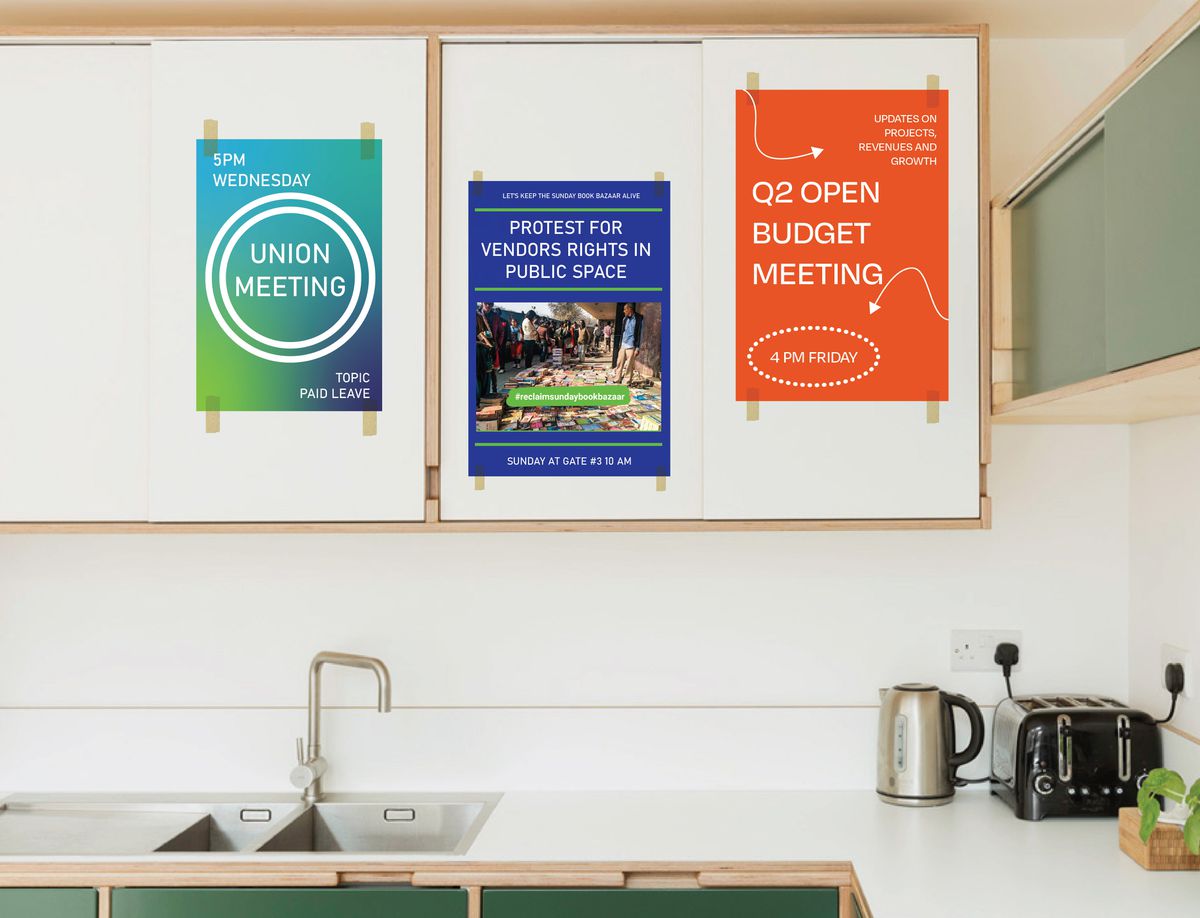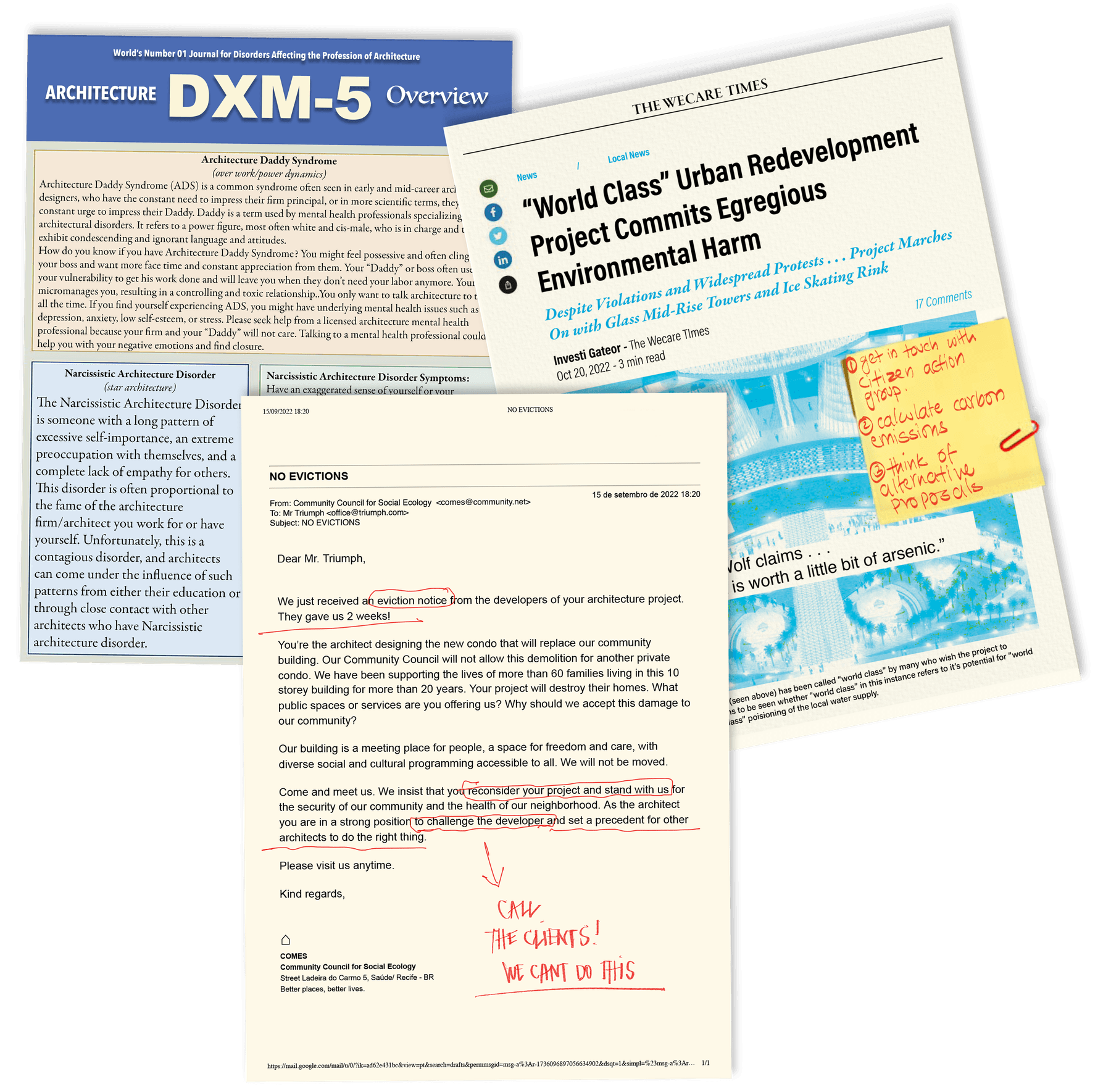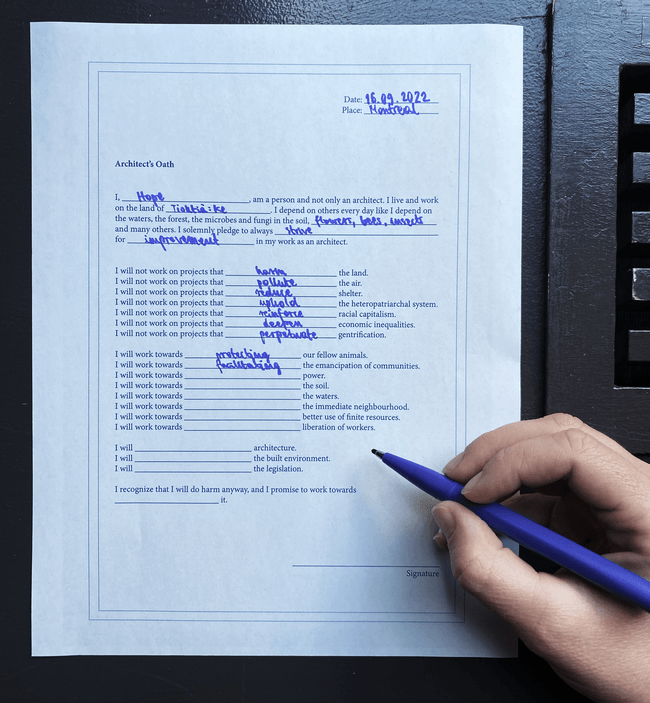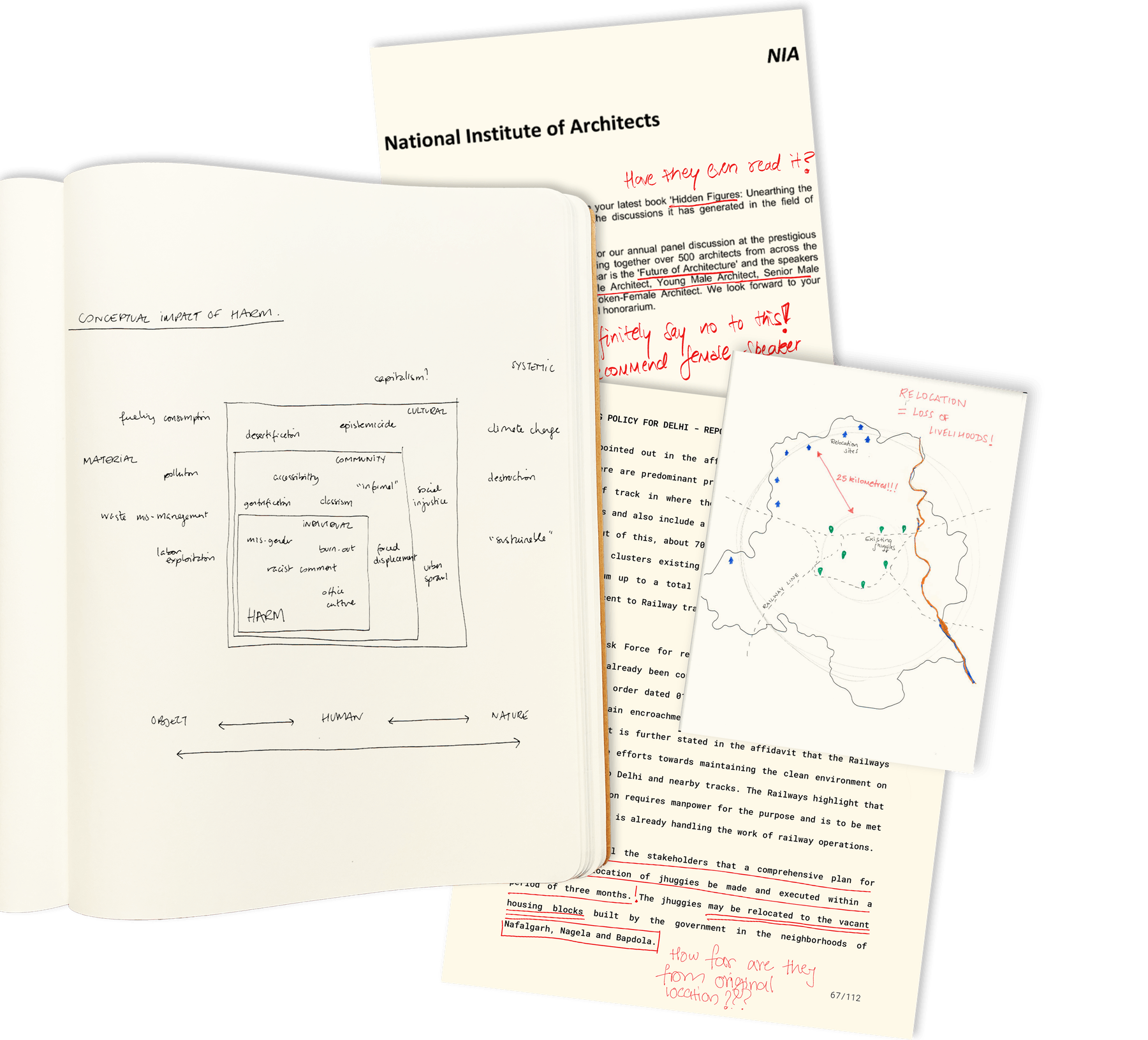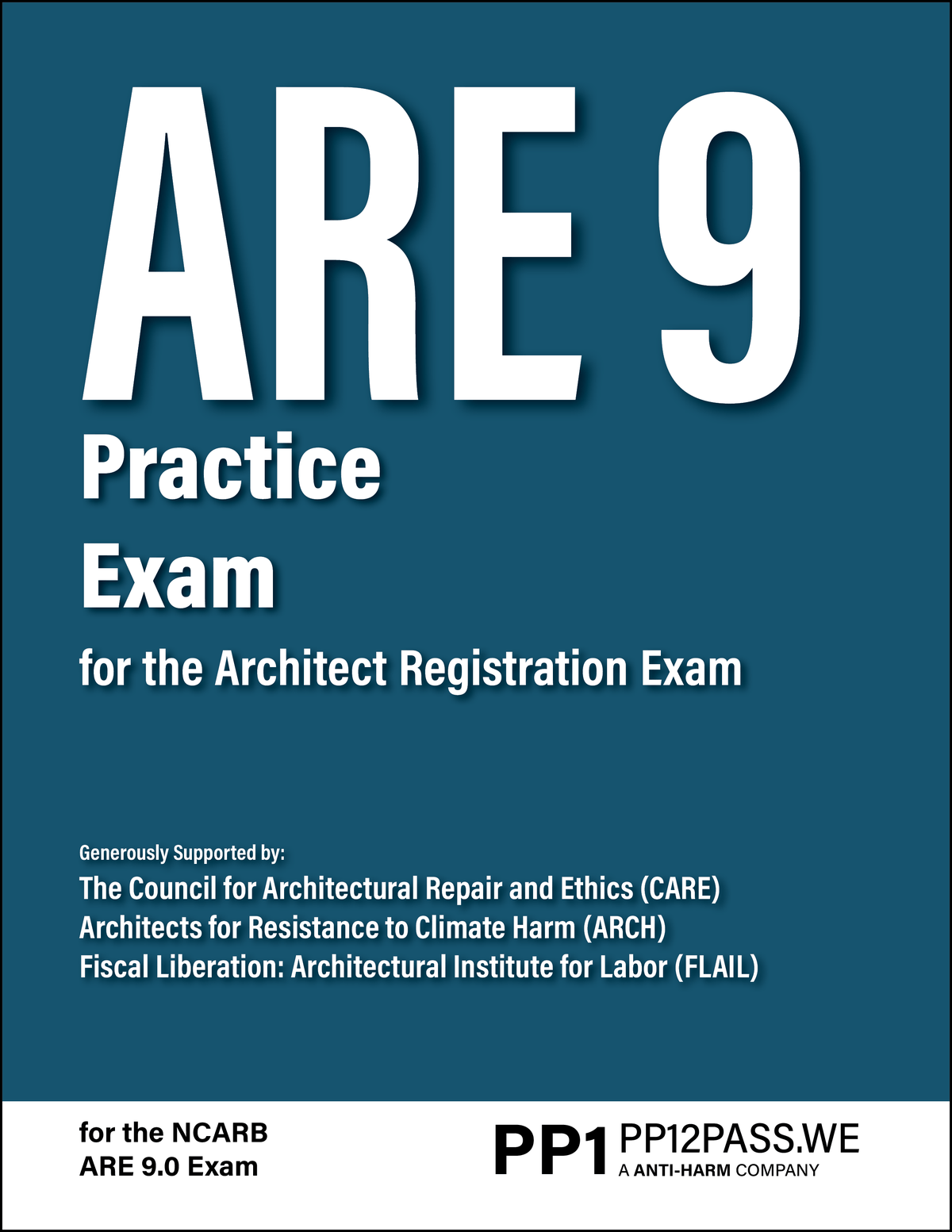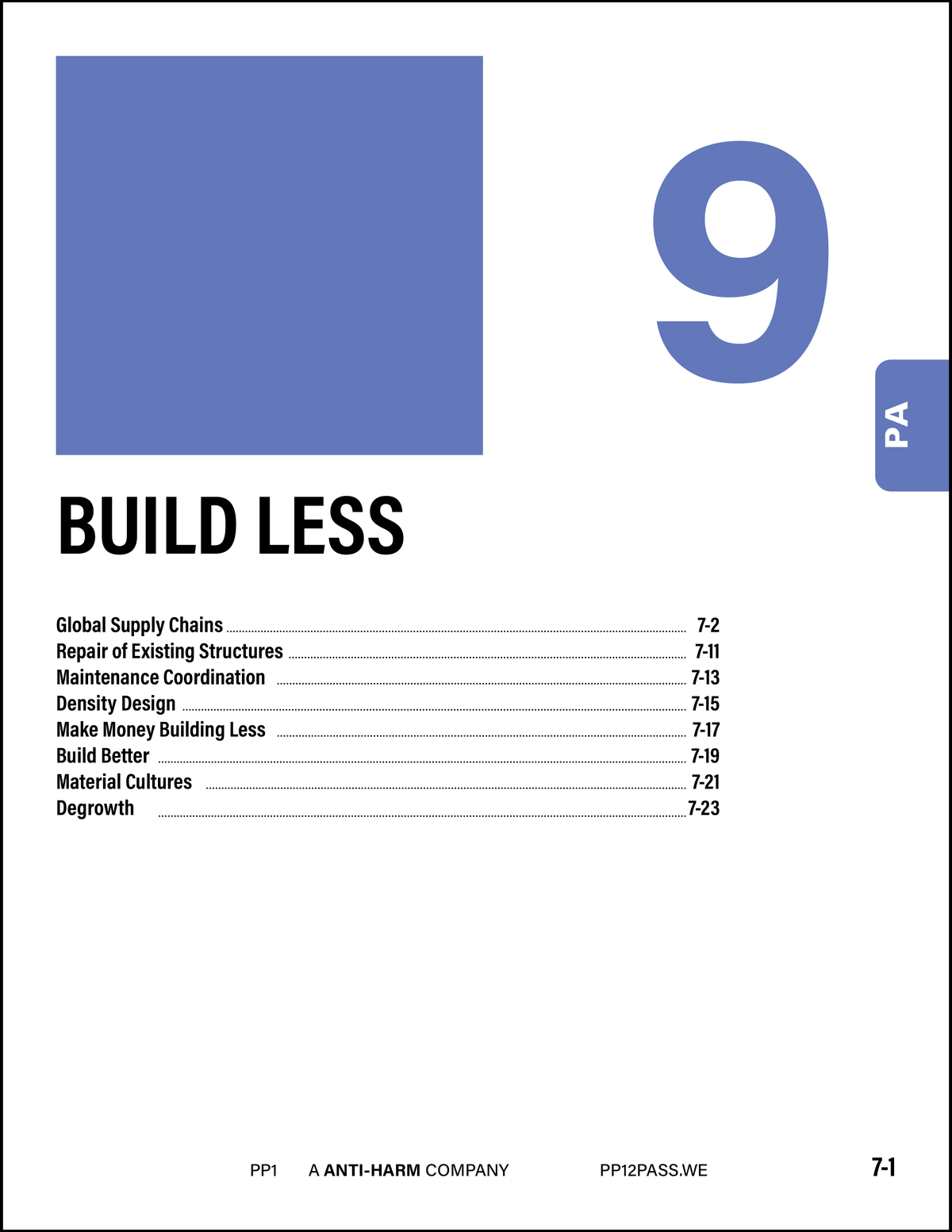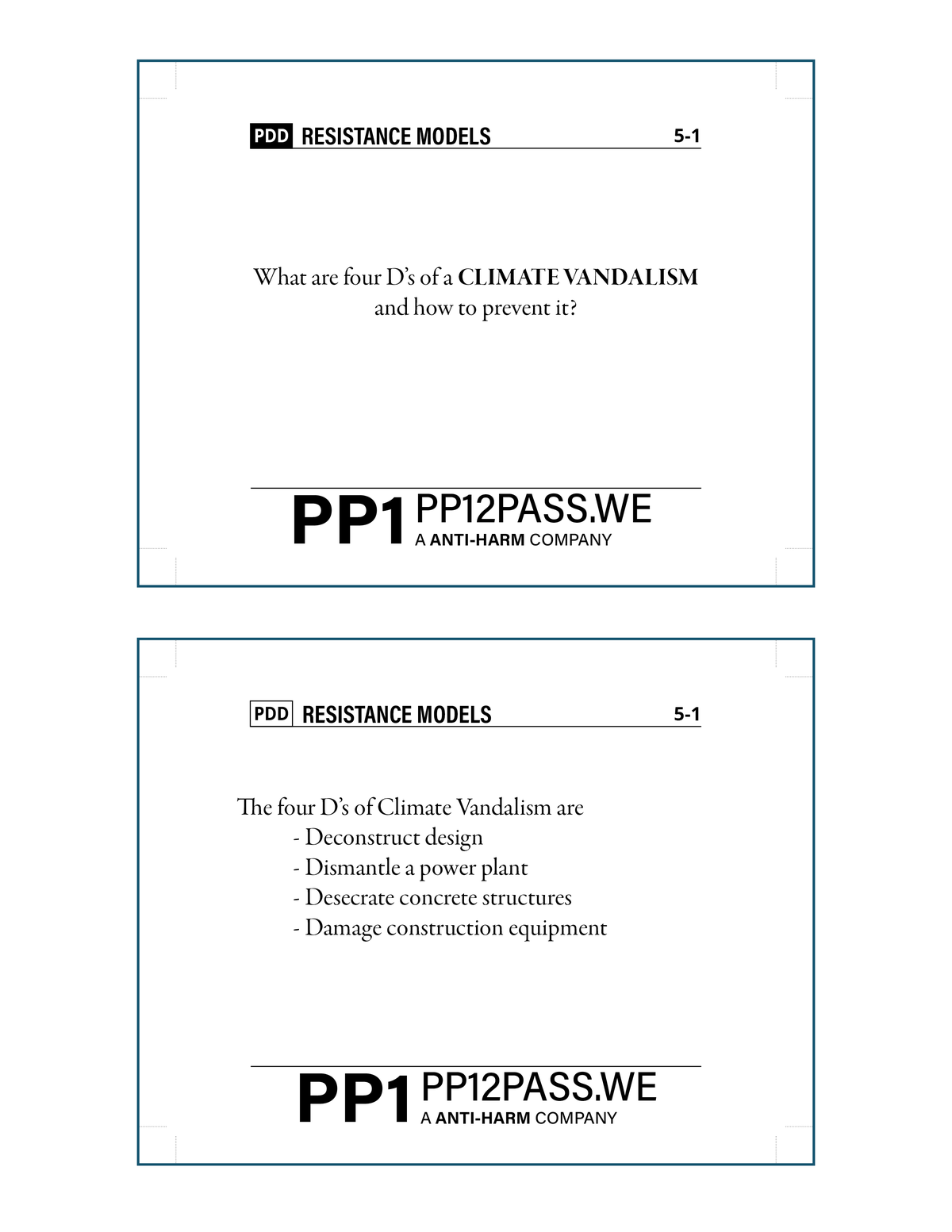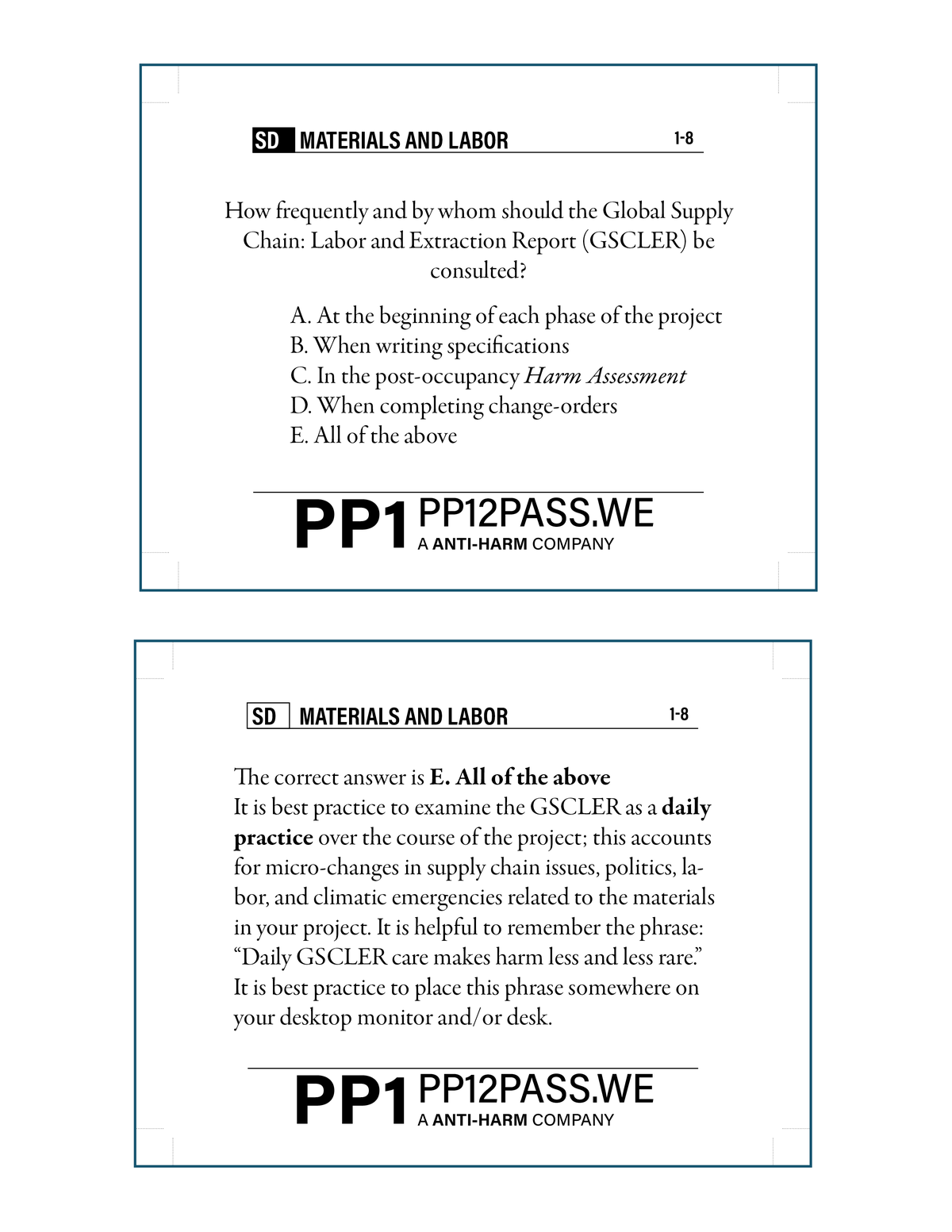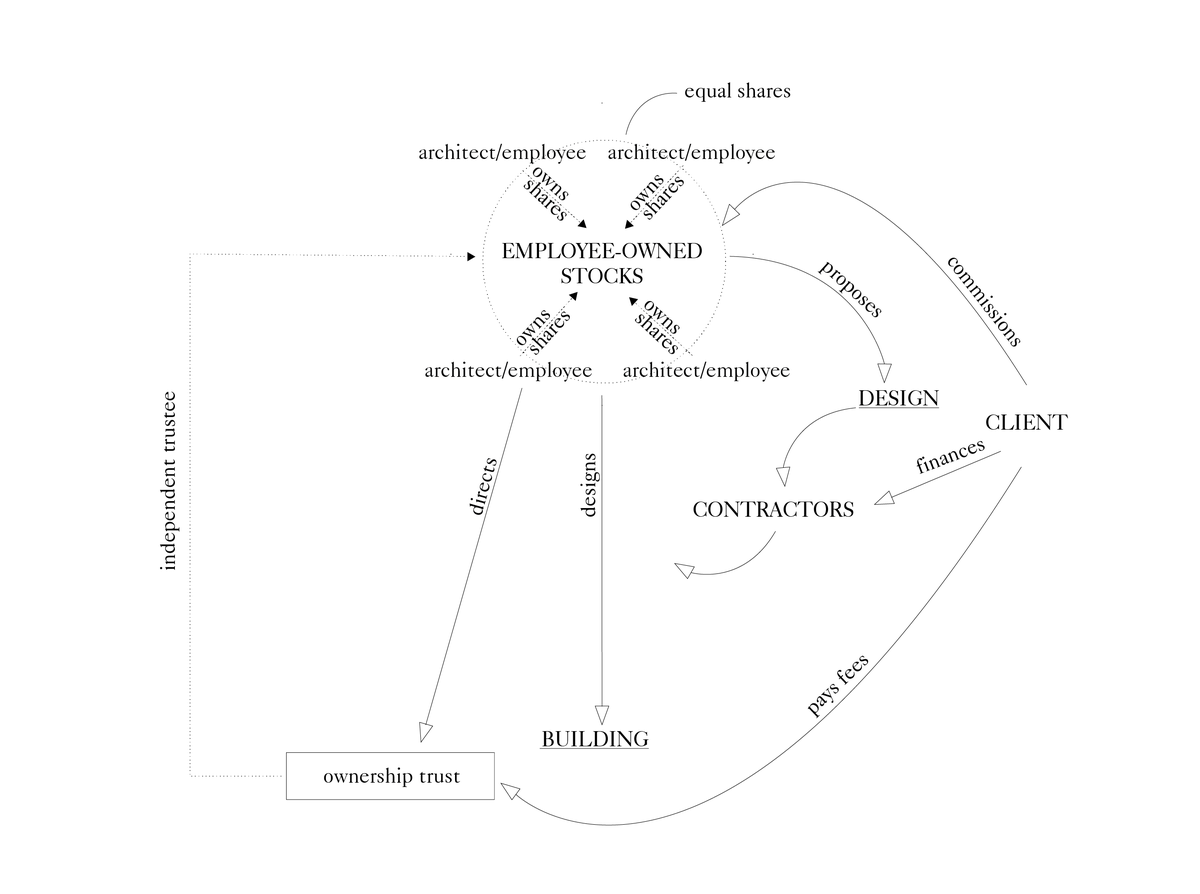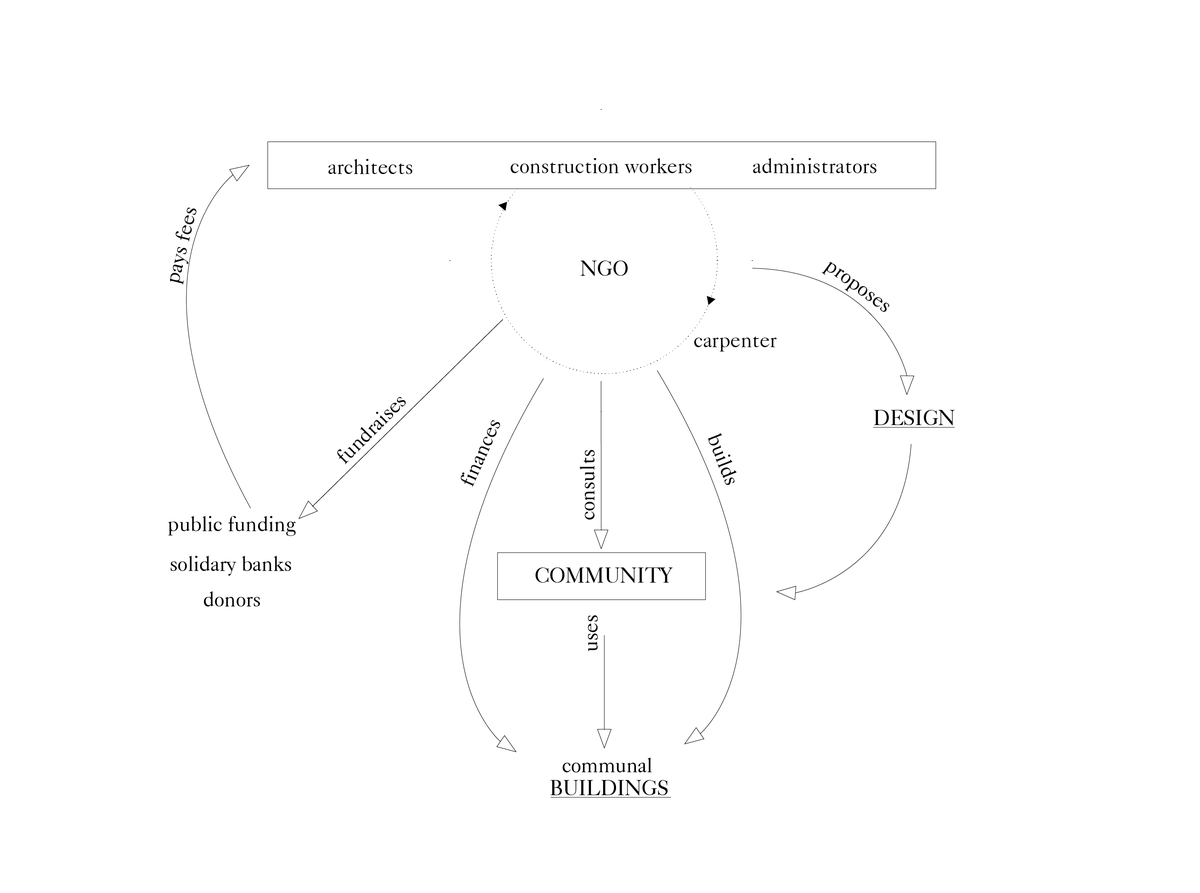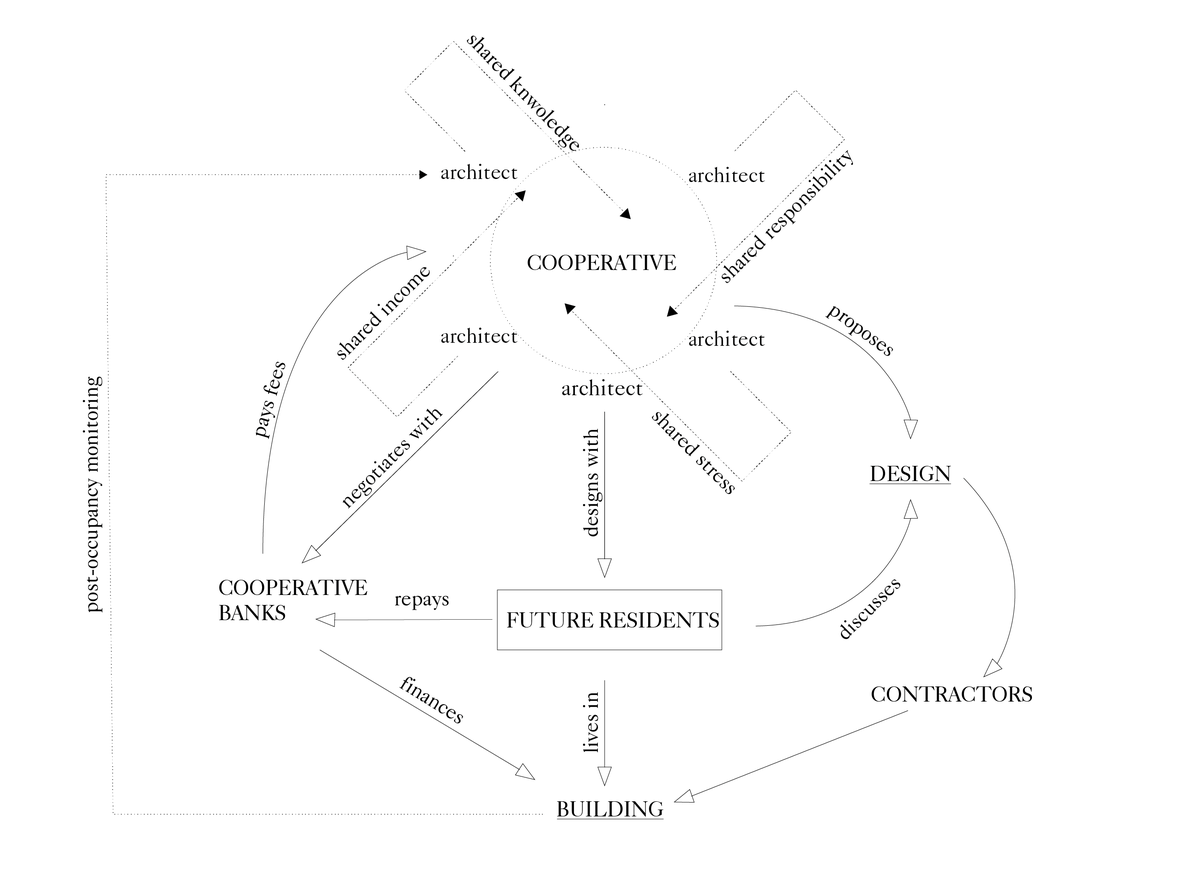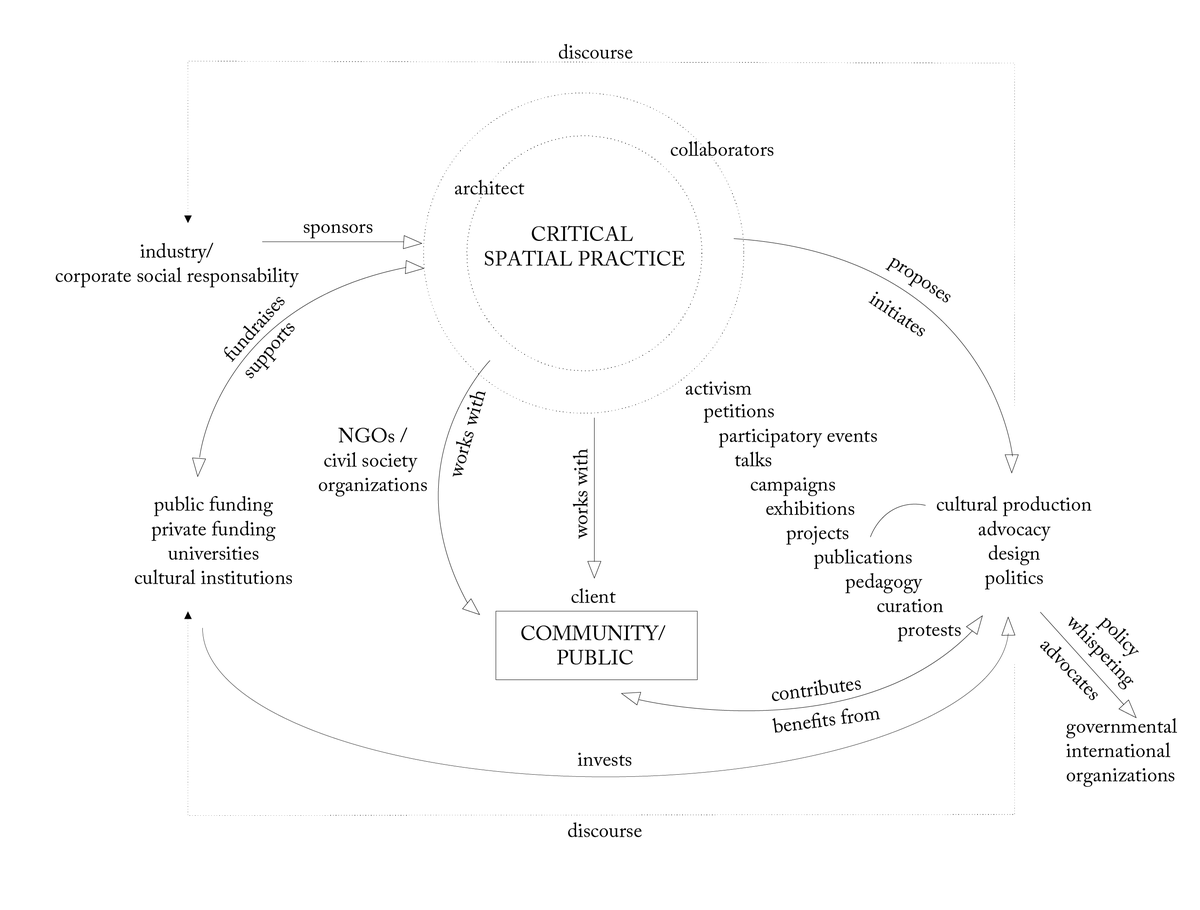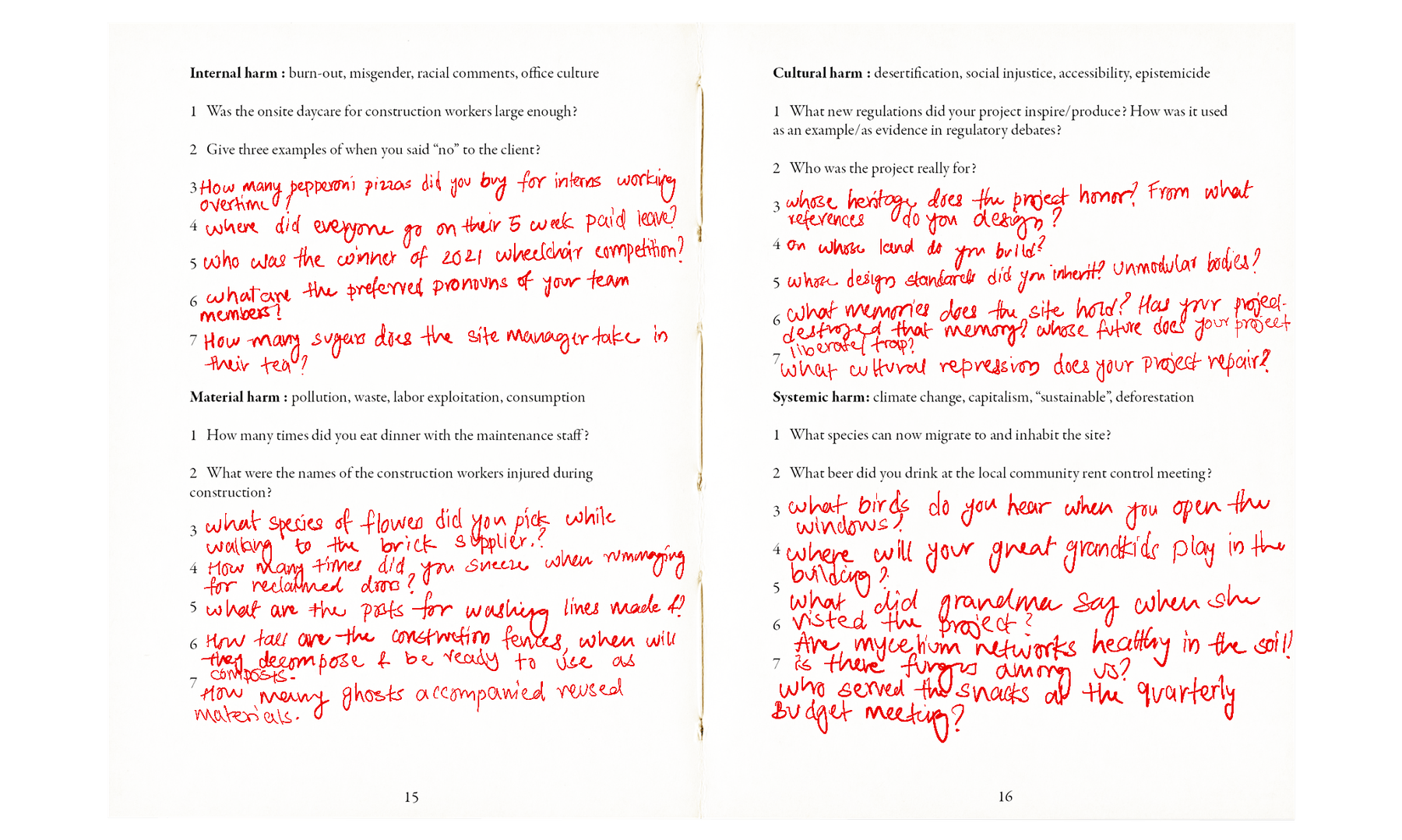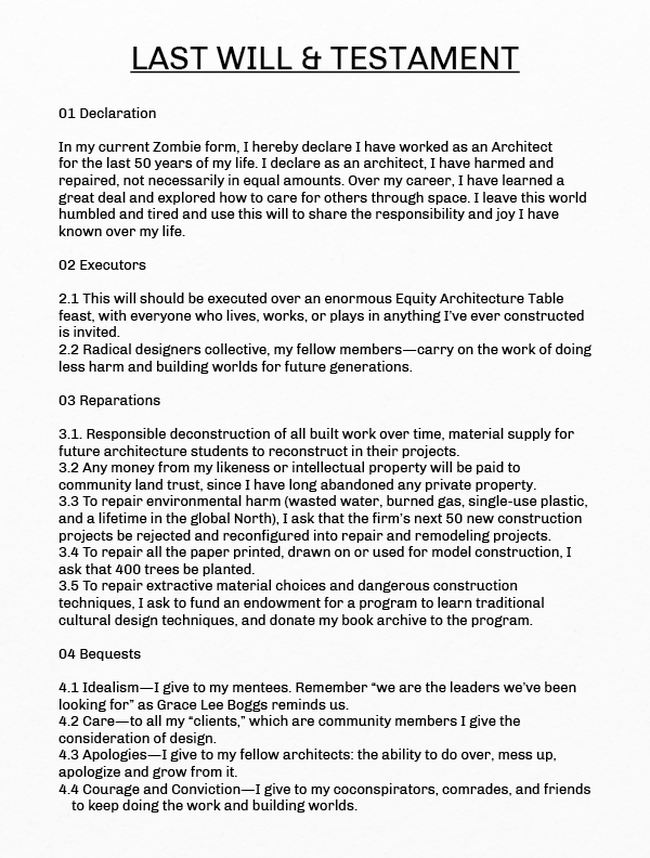How to: do no harm
Conflicted diaries by Amélie de Bonnières, Lev Bratishenko, Sophie Weston Chien, Marianna Janowicz, Swati Janu, Charlotte Malterre-Barthes, Mariana Meneguetti, Bailey Morgan Brown Mitchell, Loránd Mittay, Samarth Vachhrajani
This will only hurt a little.
It is not easy to accept that one’s profession causes harm. We like to think of ourselves as good people—and most of us are. But we live in systems that we did not choose, feel unable to change, or may not even perceive. When we harm other living things, or the world sustaining our bodies, cultures, or even ourselves as architects, it is most often because it seems we do not have any choice.
Following a possible career path of an architect is one way to explore this world of hurt. This journey starts with the initial shocks of encountering architectural culture, and moves into the grind of first jobs, and then the search for other ways of being an architect—reclaiming agency and being able to choose what kinds of harm you will do. In mid- and late-career positions, for those people whose determination, creativity, or privilege allows them to remain in practice, comes greater power and both new opportunities to create alternative practices, as well as new temptations of complacency and rewards for complicity.
Whatever choices we make, we will do some harm. At every turn there are possibilities to choose to do less and to accept the responsibility to repair the harm that we do. It is never too late, or too early.
We hope you will recognize yourself somewhere in these entries.
1. Diary of a student
Dear Diary,
The first week is over! It was so exciting, even if Structures class was boring, but I guess it’s important for me to learn that stuff. In my studio we are designing a small pavilion in a park, and I want to see how the locals already use the park. What do they need? I want my architecture to be helpful. Being in the studio feels great and even late at night when I can see other students on the grass outside, I feel like staying and working. Everyone seems as excited as I am and it feels special to be working together in exactly the same way. Students in other fields just don’t get it.
I can’t wait to finally design something, real architecture stuff, but it is so much work and sometimes the exhaustion takes over. The tutors and Professor Wiseman talk a lot about “form” but they don’t seem interested in the park as a real place with real people. Isn’t architecture about people?
Dear Diary,
It’s been four weeks since the semester started and I’m noticing some annoying stuff. Wiseman doesn’t seem to care what we’re interested in. I realized that for my pavilion project, many in the community enjoy open green space and wanted more seating areas in the park. But everyone else is designing cool, big, imposing buildings and are getting so much praise, and I don’t understand what they mean when they comment on my work. I feel like I’m not fitting in. Am I not being ambitious enough? Does architecture always mean building something new?
Dear Diary,
First crit today… going into it, I felt so proud of all the work and research I’d done, especially knocking on doors (which was kind of scary) and asking people to talk to me about what they wanted in the park. I felt like I’d really tried, but my review was so bad. Whenever I talked about that part of the project, the critics just ignored me (all dudes btw), like they didn’t understand what language I was speaking, and then they went back again and again to form—the plans and sections. What is this obsession with sections? They hardly even asked me questions and just talked to each other.
Dear Diary,
The semester is almost over and I think my professors might be giving up on me. Wiseman actually suggested I switch degrees. It felt awful, like I’d failed. But who have I failed? I want to prove them wrong. Last night I fell asleep at my desk at like 2:30am making a model (everyone’s talking about it today which feels cool). When I woke up, someone had covered me with a jacket. That was nice. The semester has been exhausting, I haven’t been able to talk to Ma at all, and she called me three times this week. I feel awful. I should call her and grandma. I have been thinking a lot about if I will finish architecture school. Is this right for me?
2. Diary of an intern
Dear Diary,
Derek asked me to get coffee, then he left for a meeting and told me to write an email to the client of the school project, but then he said I had to send the email to him before I could send it out. And then he sent it back to me entirely rewritten. Why doesn’t he send it himself? It takes longer to correct it! I get it, I’m here to learn. But it’s also so humiliating. And he asked me to come tomorrow at 6am to prepare for the 9am meeting with some developer—set up the room, plus print out three sets of all of the drawings, bring in the huge model from the model room, and plug the computer and projector in. This means I had to take the 12am train home (full of creepy guys). I’m writing this at 1am. Now I can sleep for like three hours, before taking the first train back.
Dear Diary,
This morning, Derek showed up as I was carrying the model in and he changed the whole project an hour before the meeting. He told me to update the model and when I said, what about going to the meeting? He just laughed and said “interns don’t attend.” So I spent the whole meeting bringing in updated model parts piece by piece while he presented the stuff I did yesterday. I guess since I’m unpaid and they made me register as “self-employed,” I can just walk away? Lol I wish. I did get that free metro card though.
Dear Diary,
Today Derek screamed at me in front of everyone in the office, because he said I drew the hatches for plywood in the wrong direction in Revit. And then I didn’t have time to change it because another partner told me to go to his house and help his wife fix their washing machine. Honestly, that was cool because I got to be out of the office for three hours. We didn’t figure out how to repair the washing machine, but she did give me a snack.
Dear Diary,
Ugh, Derek called Jay the name of another Indian guy at work. I didn’t know what to do, so I just walked away, but now I feel ashamed. It’s like that time when Derek told Maria to take the meeting minutes when she was the only woman there. When she told me, she seemed really upset, but she couldn’t say no, so she just did it. I didn’t feel like I could say anything.
Dear Diary,
Sorry I’m neglecting you; work has been so intense. I missed my doctor’s appointment yesterday because I had to make like a thousand versions of the competition project in blue roofmate foam. It was actually fun but the fumes made me feel sick. It’s nice to work in the model room: I can listen to music and I can’t hear any yelling. The cool thing with the competition is that (even though the overtime is not paid) there was free pizza every night this week. And right after we submit it, there’s the office party. Looking forward to that!
Access and add to the Office Resistance Manual. Username: howtodonoharm, password: bananass
Dear Diary,
Even though Derek didn’t credit me in the project team for the competition, I am so proud of the work we did. I think we’re going to win. The facade looks amazing, all in COR-TEN steel cladding. When I told Aaron about it, he gave me this strange look and started talking about how all of his uncles worked at a smelter and how bad it is. I had no idea. We picked it because it looks good. We never talked about where this stuff comes from or who makes it. Would we even use steel from here—doesn’t it all come from China? I guess once we win, we’ll have to figure it out. The office party was not as nice as I expected. All the partners got wasted and one of them got a bit too touchy and said really embarrassing things to Maria. She left, and I felt bad that I didn’t say anything again. Someone puked on the printer.
3. Diary from the first job
Dear Diary,
This was my first full week as a Real Architect. It doesn’t change much except now I have real liability if a project goes wrong. I spent the morning browsing the specification system. It’s like a massive shopping list. Then there was a “lunch and learn” with a steel company representative talking about the advantages of steel instead of concrete: faster, recyclable, and reusable. When they showed the carbon footprint comparison, I wanted to ask about cross-laminated timber but I felt too shy. I just started here.
Dear Diary,
We started a school extension project using steel construction. I called up the sales rep and he was super helpful, advising me on the right products and details I should use. I tried to convince Carlotta with a feasibility study for using timber instead but she said the client would never spend the extra money. At least I tried, but why wouldn’t she even ask the client?
I researched the best ways to fire protect the steel beams and it seems like the building control inspector, the structural engineer, and the fire safety officer each have their own “correct” way to do it. But the client only wants to use the cheapest compliant method. Cementitious plaster it is.
On Wednesday, I went on site and talked about fireproofing with the foreman. He’d never used this method before so he was skeptical and it felt a bit personal. Stupidly I wore a skirt, so of course someone on the site made a joke as I was about to climb the ladder. It will be trousers to site visits from now on.
Dear Diary,
The old school building has beautiful steel windows. I made an inventory of them. Many frames have now warped and some won’t close properly because layers of paint have accumulated in joints. We are going to propose installing identical metal double-glazed windows to improve the building’s thermal performance. I searched the website to find out where the new steel comes from but couldn’t find anything. I called up the sales rep and he said it comes from a “certified vetted” foundry. Who does the vetting?
Dear Diary,
The conservation officer said we can’t change the windows because the building is heritage listed. I don’t get it, we specified the exact same type, made of the same materials and with the same frame profile. The double glazing would have been such a huge improvement thermally and environmentally. My boss said it’s actually okay because of the embedded carbon we’ll save by keeping the existing windows, and we can mitigate heat loss by insulating the roof. I looked up insulation panels in the specification system and found good ones. I hope they won’t be too expensive. Then over lunch Eric said they’re petroleum-based and could take five hundred years to decompose. Yikes. I found hemp insulation to show the client instead and this time Carlotta agreed. I should join the sustainability committee that some of the other junior architects just started.
Dear Diary,
I’m so frustrated. The client actually agreed to use the hemp insulation even though it was a tiny bit more expensive. I left the meeting on such a high, and then it turns out there’s a supply chain problem and we wouldn’t be able to get them for six months! So we’re using the standard panels again. When I went to the site today the workers were cutting them to size and the site manager told me to wear PPE and a mask because of the fumes. But most of the workers weren’t wearing any. Maybe they were too hot? When I talked about it with the site foreman he really didn’t seem to care. Maybe I should have checked with the manufacturer if these fumes were an issue. Was this my job?
4. Mid-career diary
Dear Diary,
After our weekly union meeting, I got a very interesting call from someone in Hefei. I answered in my elementary Chinese and I think they want me to design a heritage centre for the village my family came from. I don’t know if I should take it. I feel like I’ve been in the US too long.
Dear Diary,
I’m going to take on the Hefei project. I want to reconnect with my Chinese family and learn about vernacular styles, something I never got a chance to do in school. I can barely remember what the town looked like, it feels like all of the modernism I was taught just flattened everything else. Last night, I watched a lecture by Menna Agha where she talks about epistemicide, the destruction of existing knowledge. It really resonated. In my case it’s erasure by assimilation. I guess it’s a kind of violence, but I’d never thought of it that way before.
At school I couldn’t even go back to China on exchange, the only option abroad was to study in Rome.
Dear Diary,
I’m back from visiting the primary school the office finished five years ago. We were right to include post-occupancy care in the contract: 10% of our fee for maintenance and repair over the next 150 years of the building’s life. Until now we’d only added a ramp up to one of the entrances, but after talking with the kids, parents, and teachers, it’s clear that we need to help them adapt the building. There are more and more migrant families here and the school is integrating them in smart ways, but many spaces could work better. I’ll go back in a few weeks for another workshop. The budget is tight but the Carceral Abolishment Amendment Package funding makes it so much easier. I can’t believe how much money we used to waste on the police and prisons! Ten years ago, when I was at HIK, they actually called their prison projects “Justice Design.” They lobbied so hard against the abolition bill and I feel so embarrassed that I ever worked for them. I remember telling this project manager my doubts about the prison system and how he smirked and said that work was paying my salary. Damn, it felt good to leave that office. I don’t even put it on my resume anymore.
Dear Diary,
Just got back from China, where I was able to go see the site in Hefei and meet some crafts people in other parts of Anhui. It was incredible and really, really hard: I don’t have the right words to talk about making and building in Chinese. All of the vocabulary I have from school makes no sense to the builders. And without precise words, I had a totally different relationship to designing. I feel like I said yes too much, since arguing was so hard. I felt disempowered, and totally removed from my ancestors and the knowledge they held. I keep thinking about what Nai Nai would think of all this, and if she would understand the design.
Dear Diary,
I’m so tired. Yesterday, we did our second workshop at the school and it lasted until 9pm. Navigating the needs of the students and teachers as well as the restrictions of our Carceral Abolishment Amendment Package fund is going to be very tricky. We just found out enrollment will be 20% higher next year, and so we have to find a way to build five more classrooms. CAAP money can only be used for repairs and maintenance, so we have to “repair to expand” in order to create room for all of the students. I’m hoping we can use this restriction to expand the design workshop at the school so kids can spend more time building outdoors.
5. Diary of an eminent architect
Dear Diary,
I’ve done harm. But I’ve resisted. There were moments when it was futile but many others when it was revolutionary—turning points that I’ve started calling resistance moments when I lecture. These have defined my career and made my life. In a world of harm, resistance is possible at every moment.
Dear Diary,
I remember when we joined the Alliance for Equitable Licensure and I gave up my license—refusing to complete projects unless licensure fees and testing requirements were made more equitable—it really hurt. We lost seventeen projects that year because of it and nearly went bankrupt. When Architects for Resistance to Climate Harm took on the challenge of examination reform during the license strike, just building consensus about the “Build Less” chapter took six months of debate over which sub-topics to include, as well as a team of nine researchers working for half a year to study the reality of global supply chains and extraction models.
Dear Diary,
I look back fondly upon the dinners with building maintenance staff that I’ve had over the years, especially before they all joined the firm full time. So much trust and knowledge was created around that table, ultimately increasing the longevity and maintainability of our projects. In retrospect, recognizing that I was a construction worker too was one of the most important turning points in my life.
Solidarity Game: gather your friends and play with the power of the collective. Download a paper copy. Don’t be disappointed if you never win.
Dear Diary,
Quietly within my design team, we began incorporating new questions into the design process “On whose land do we build?” and “What memory does the site hold?” which have fundamentally recalibrated our responses to political and cultural histories of the site. These small acts of resistance questioning have led to two much louder movements: Architects for Land Back and the non-profit high school education program, Memory Markers for the Eighth Generation which supports Indigenous kids and grandparents in memory-making through art and design installations on sites of contested histories. These organizations later led to our outsized participation in the Secretary of the Interior’s Indigenous Co-Stewardship of Cultural Landmarks program.
The union and I met for months and explored different restructurings, which ultimately resulted in the Flat Power Model. We would never have been able to embrace the “little harm, big risk” model in our work before construction workers, architects, and administrators were all at the same level in the firm. Additionally, freeing a more speculative wing of the office into a 501(c)(12) Critical Practice model allowed us to invest directly in policy whispering and cultural production.
Dear Diary,
We’ve added other resistance questions. “Where will your great grandkids play in the building?” has helped us consider the longevity of our buildings while “What birds do you hear when you open the windows?” has helped us understand the broader ecologies into which we insert ourselves. Individual architects have also developed their own resistance questions that include “Give three examples of when you recently said ‘no’ to the client” or “Whose design standards did you inherit?” Recently these resistance questions have been formulated by Critical Practice into a Harm Assessment Guide that is being shared through a cooperation with the The Council for Architectural Repair and Ethics.
Dear Diary,
Was the harm we did worth it, if it sheltered people? It is hard to let go of the urge to quantify what I’ve done to the world—all that scientistic baggage I was taught and grew up in—but I’m certain that even if I somehow could, it still wouldn’t bring me more peace. Near the end of my long career I can finally sit comfortably with the ambiguity. I know that I’m not innocent and that’s okay.
I’m thinking about my legacy for when I’m gone. Architects rarely really disappear—the firms continue for a while, for better or worse. So if I’m going to become a zombie, what kind of zombie do I want to be?
Thanks
These diaries were made in about a hundred hours over three weeks, two online and one in Montreal, which produced one hundred and nine pages of notes with over forty thousand words. It was all possible only because of the dedication of the participants and the generosity of the interviewees: Elizabeth Timme & Chazandra Kern (Office of: office), Astrid Smitham & Nicholas Lobo-Brennan (Apparata), Guujaaw, Cristina Gamboa (Lacol), Menna Agha, Sename Koffi Agbodjinou, Andrew Daley (Architecture Workers United & The Machinists Union), Jess Myers (RISD), Kaya Lazarini and Giovana Martino (Usina CTAH), Andreas Malm. We are deeply grateful to them.
We also want to thank the many colleagues and friends whose conversations and support shaped this project: Ellen Peirson, Rafico Ruiz, Alexis Blanchard Méthot, Ella den Elzen, Irene Chin, Emile Retailleau, Albert Ferré, Ismaël Mallé.
Special thanks to Hannah Medley, Alexandra Lyn, and Charlie-Anne Côté for research and coordination. And to all our grandmas and grandpas.
How to: do no harm is curated by Lev Bratishenko, CCA Curator, Public, and Charlotte Malterre-Barthes, Assistant Professor at Swiss Federal Institute of Technology EPFL.
Since 2018, the CCA’s annual “How to” residency has produced interventions in para-architectural activities like publishing (How to: not make an architecture magazine), curation (How to: disturb the public), and awards (How to: reward and punish). The residency was conceived as a platform for rapid tool-making in res ponse to specific opportunities and needs, and in 2022 it begins a new three-year cycle focused on accelerating changes in architecture practice, beginning with architect hybrids (How to: not become a developer).

